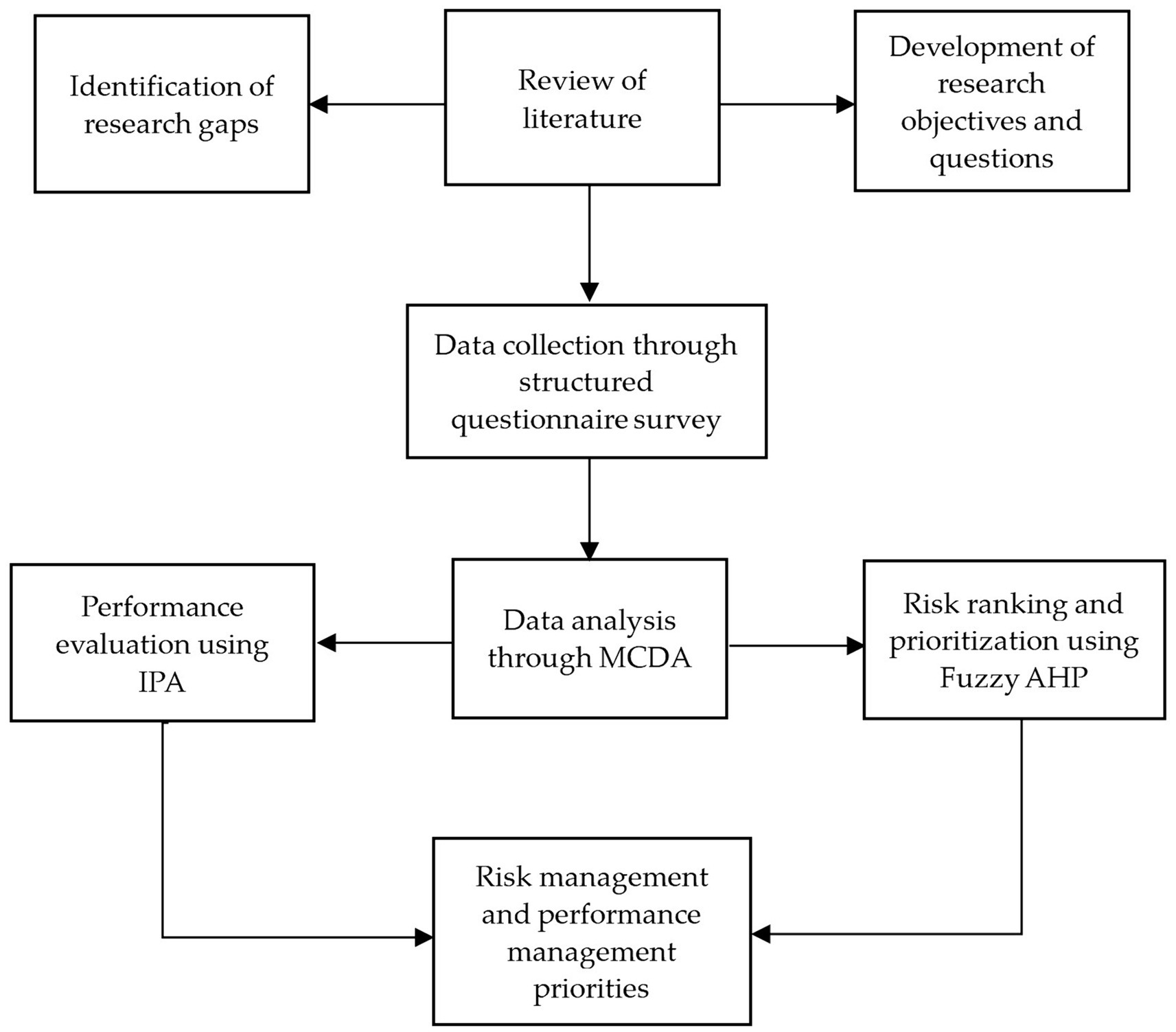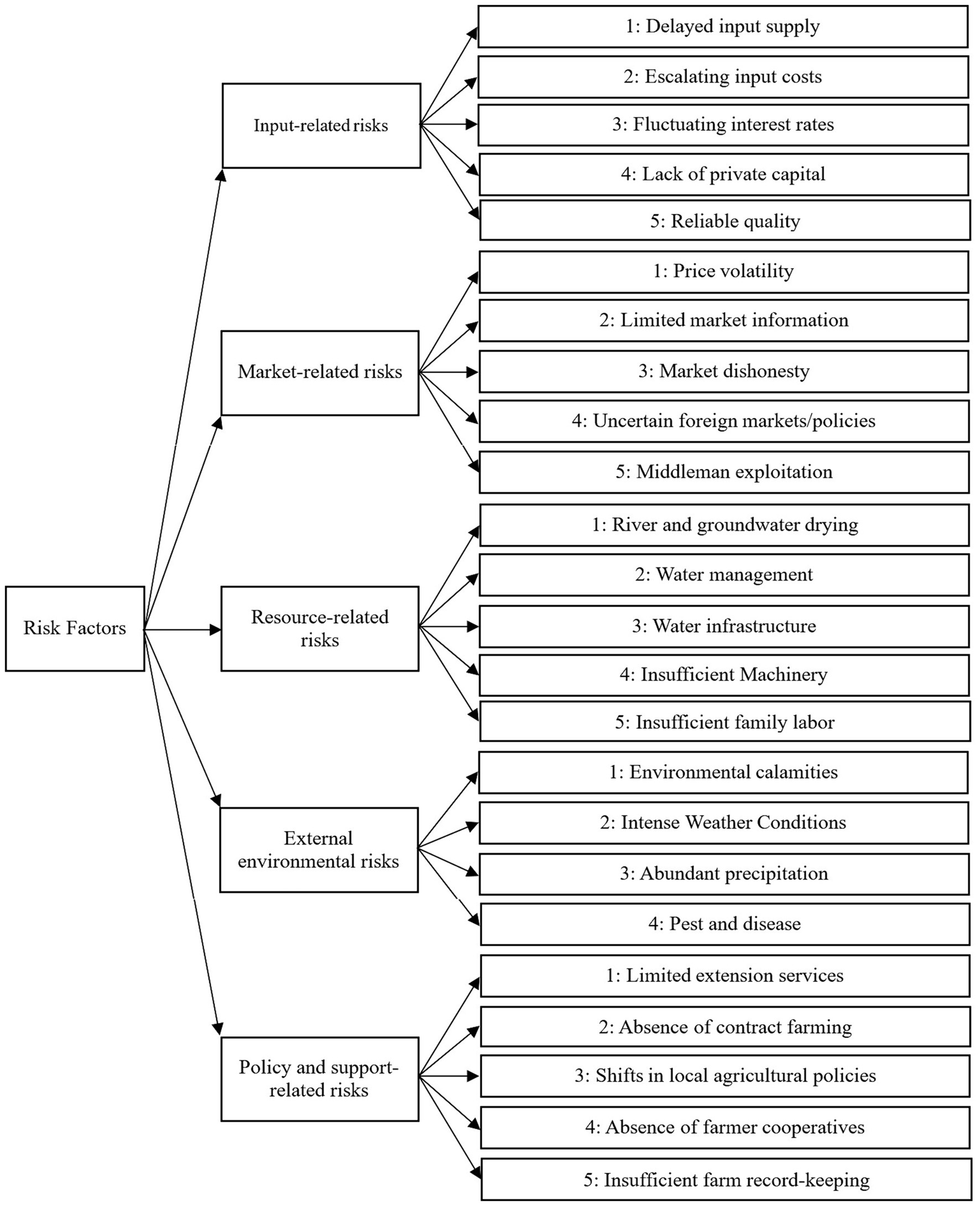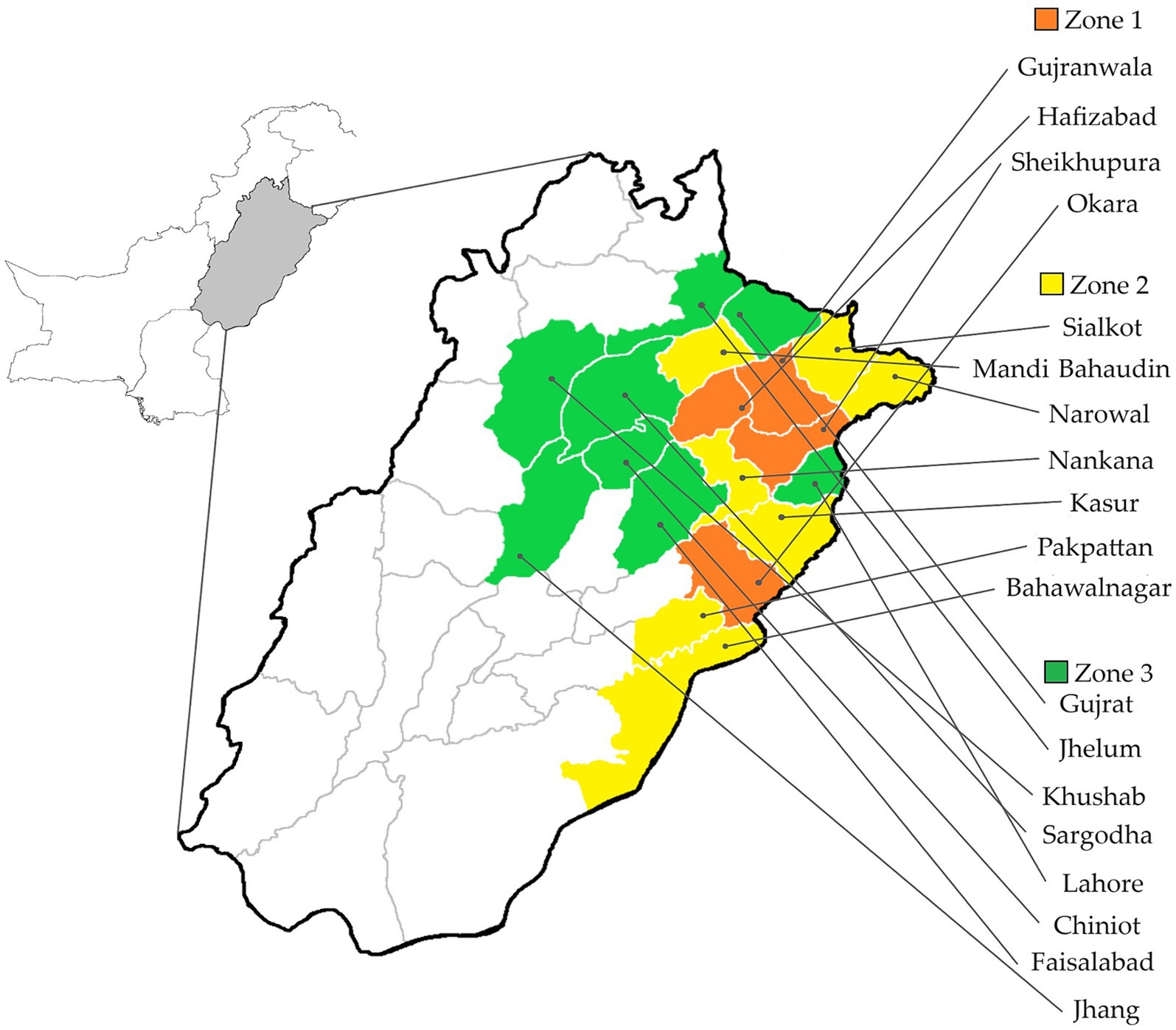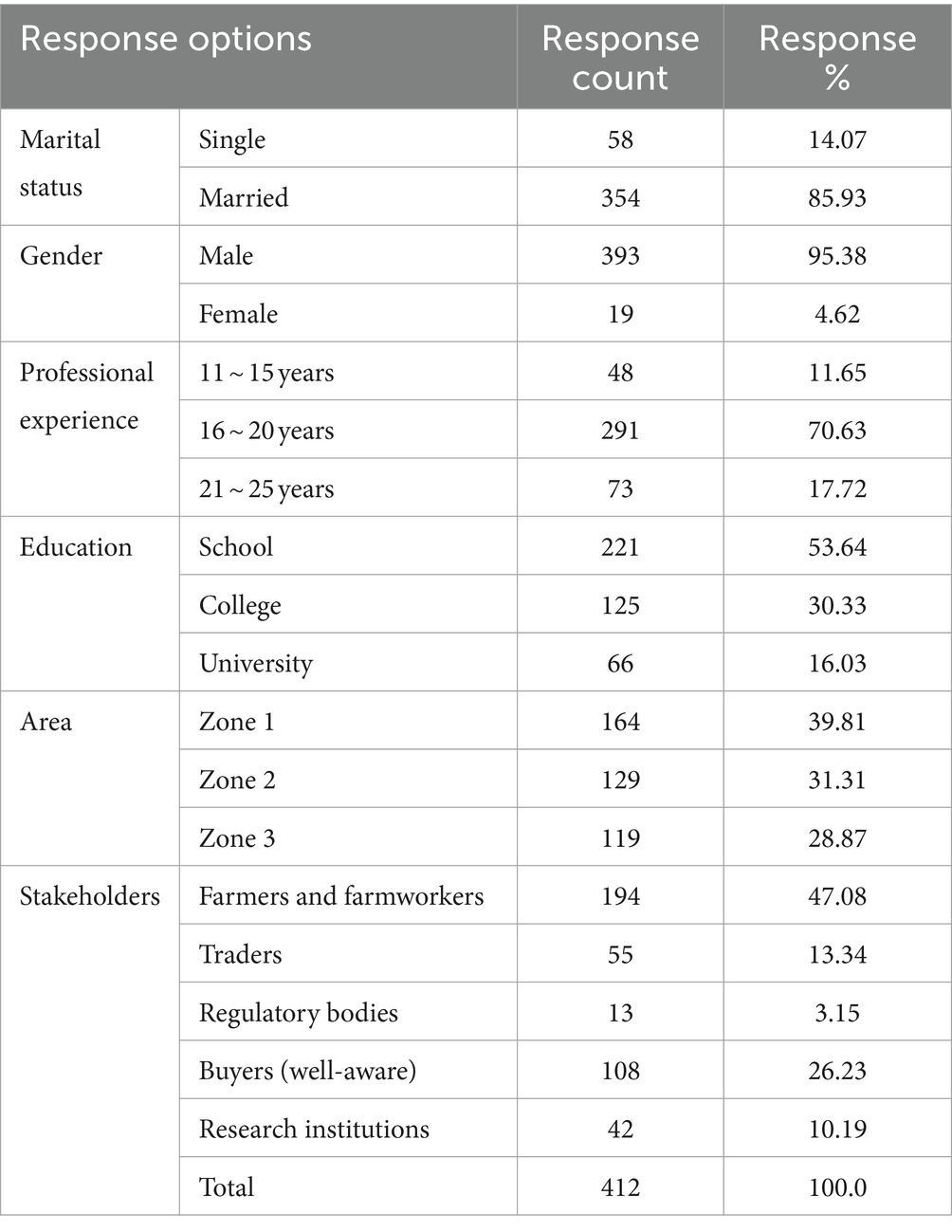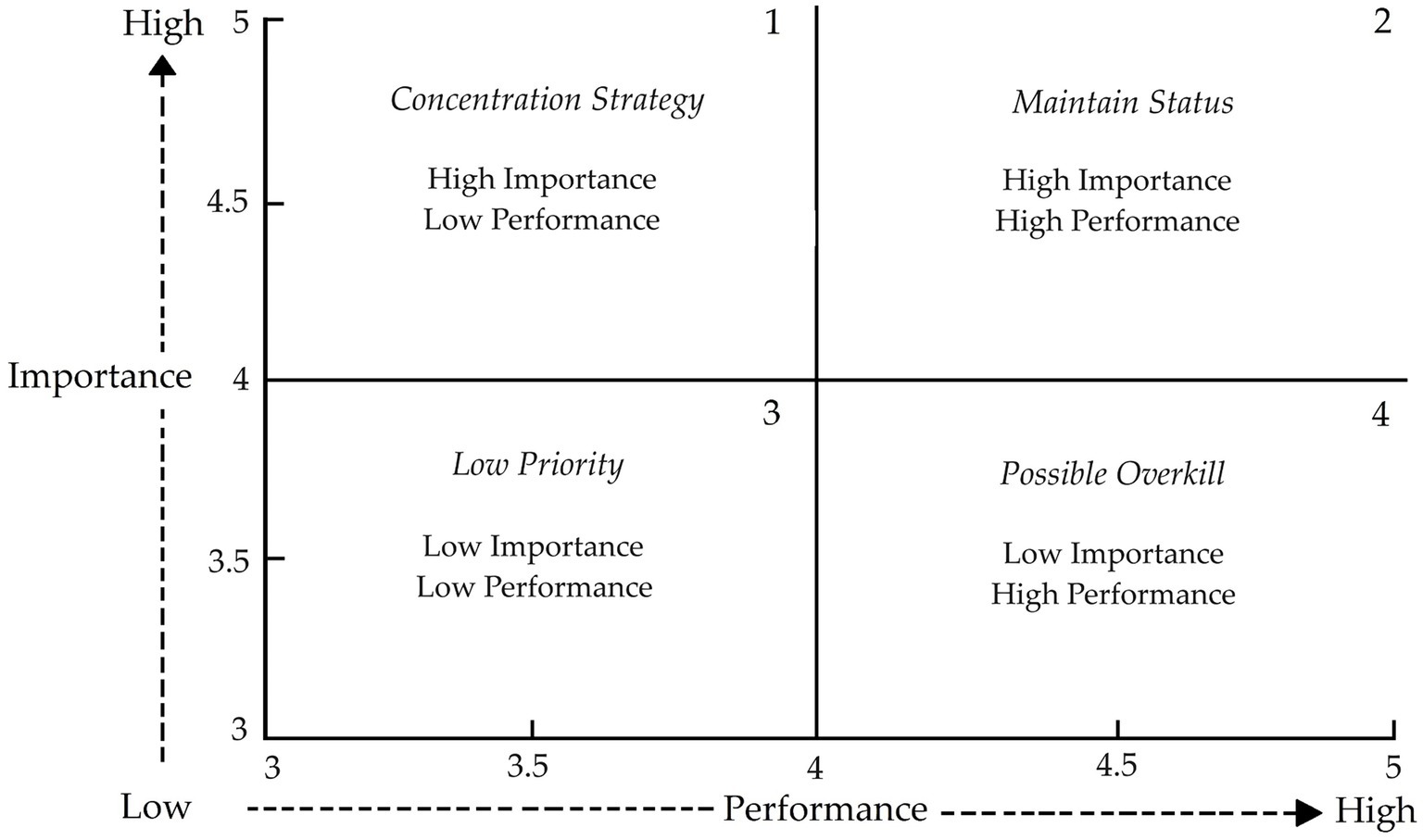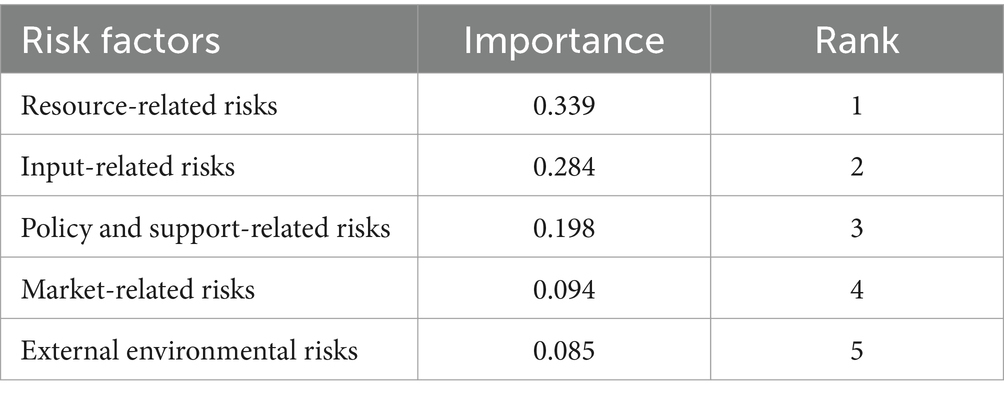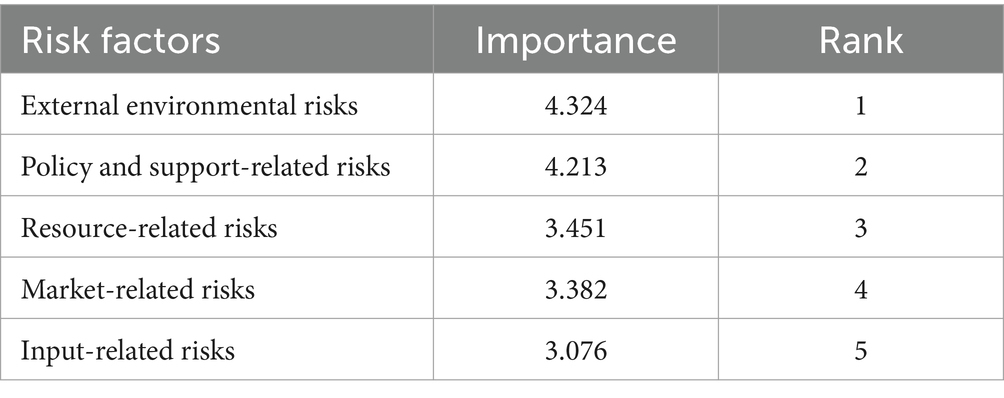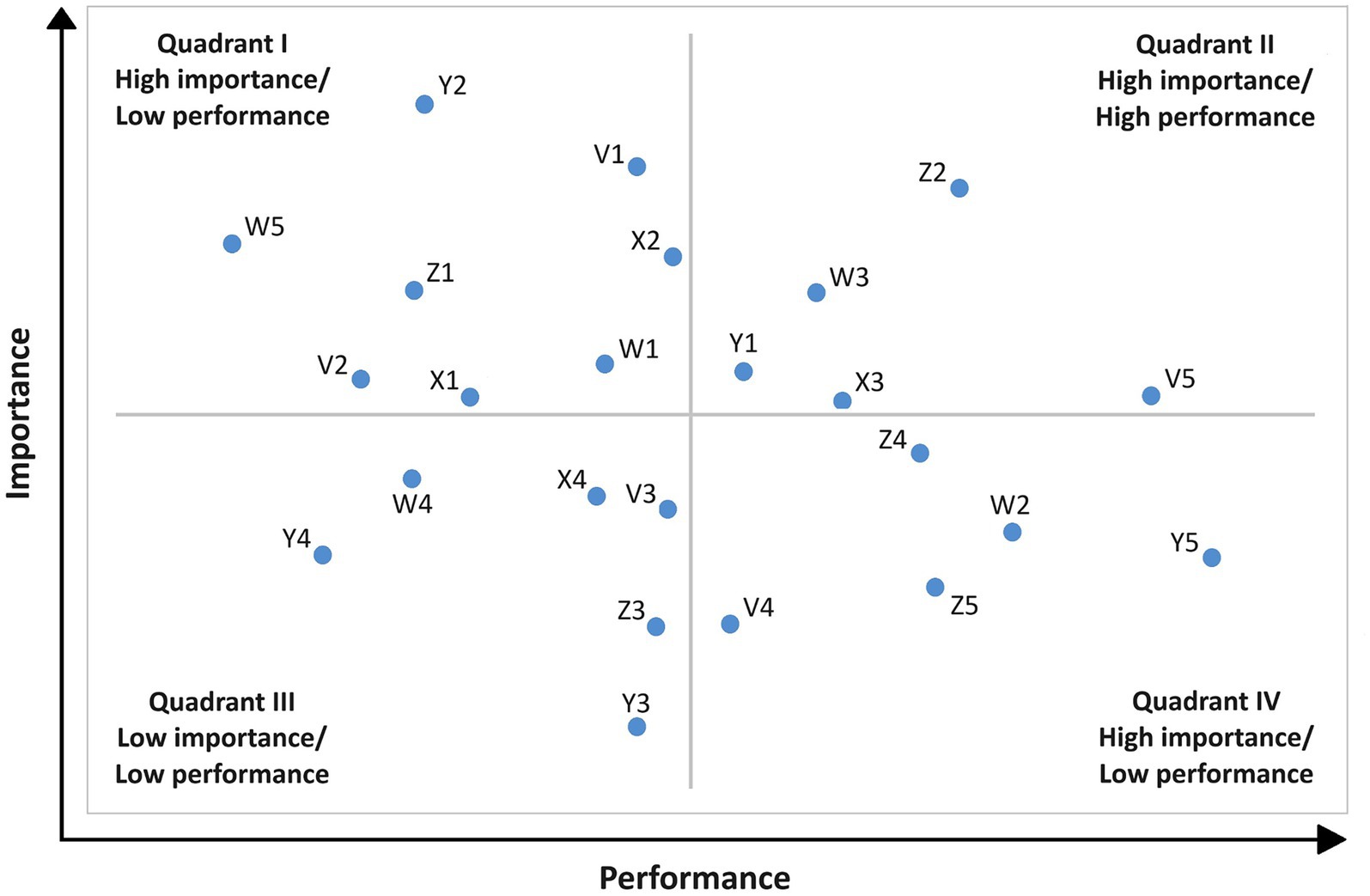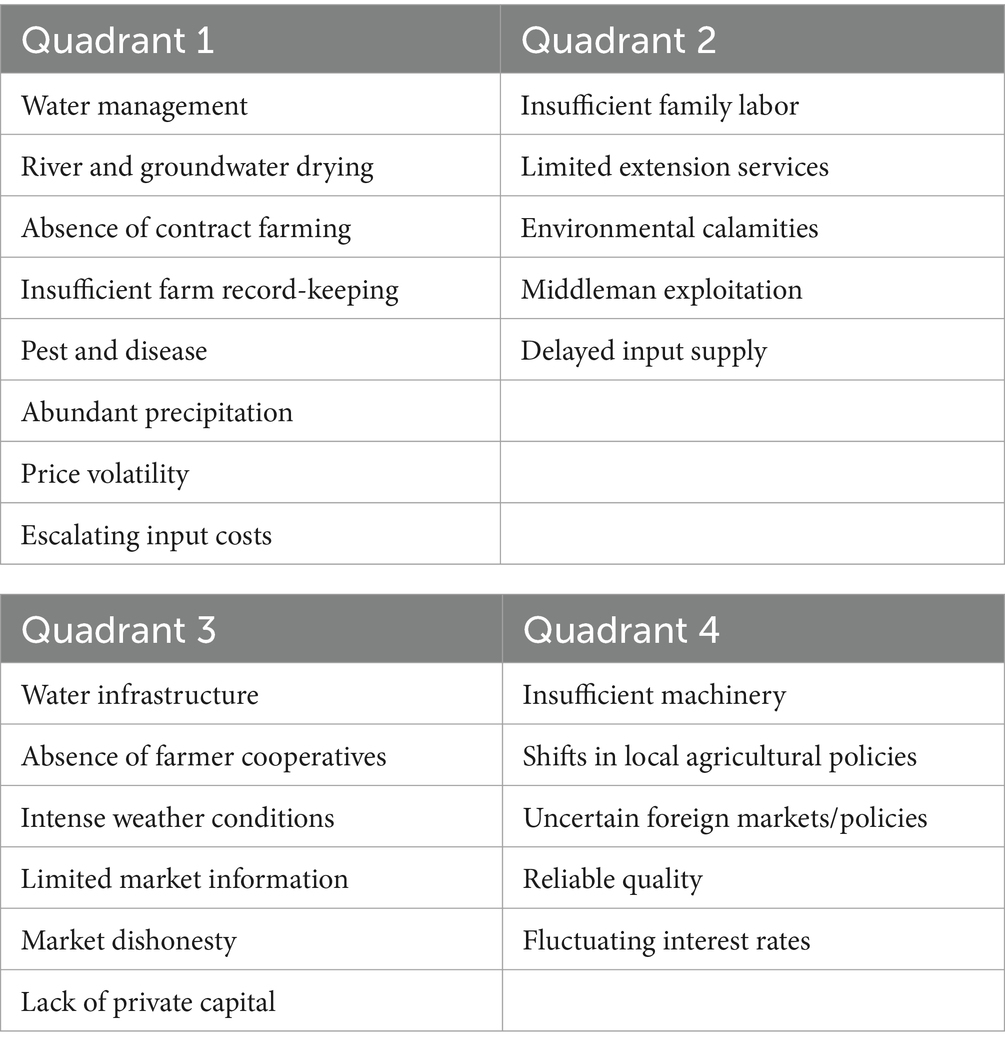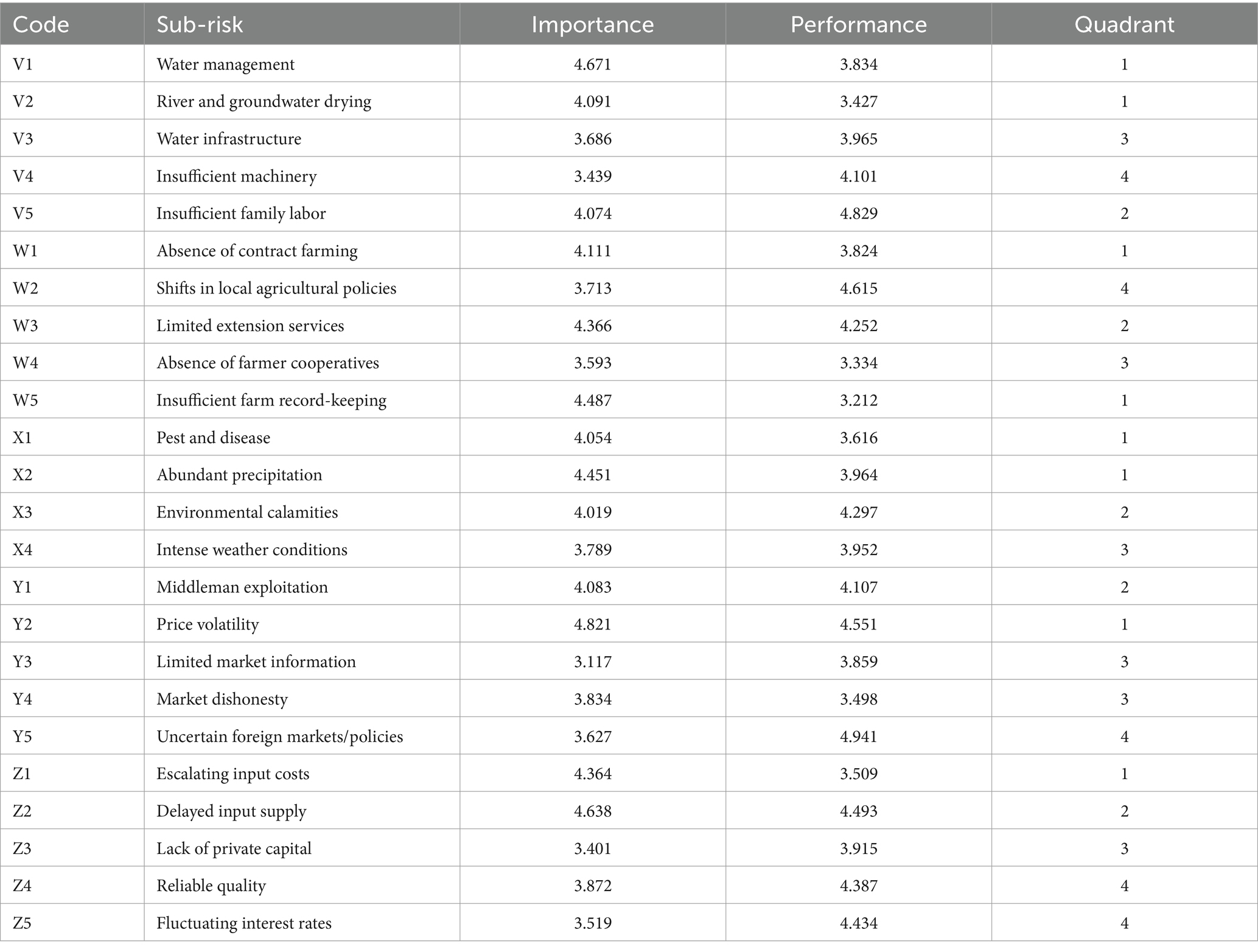- 1College of Economics, Jiujiang University, Jiujiang, China
- 2Department of Business Administration, GC Women University, Sialkot, Pakistan
- 3College of Wealth Management, Ningbo University of Finance and Economics, Ningbo, China
Rice farming in developing countries contributes significantly to economic growth, yet it confronts diverse risks. Strengthening its resilience necessitates systematically identifying and prioritizing these risks, allowing for optimized resource allocation. The majority of published literature, however, focuses primarily on individual risks rather than comparing or ranking them according to their importance. This regime needs to be more helpful for managers and policy-makers in achieving effective management. As a result, frequent management failures are causing substantial economic losses and threatening food security in the most populous regions of the world. This study addresses these existing research gaps by systematically identifying and prioritizing these risks, aligning with the United Nations Sustainable Development Goal (SDG) 2, viz., Zero Hunger, ultimately contributing to enhanced risk management and developing countries’ rice farming sector resilience. Data was obtained from Pakistan through a purposefully designed questionnaire and sourced from a pool of 412 respondents representing a spectrum of stakeholders selected by the snowball technique. Multi-criteria decision analysis (MCDA) was employed to deconstruct and comprehend the data statistically. A key observation is the recognition of the main risks within rice farming, notably revolving around resource-related and external environmental risks. These risks emphasize the critical management of sub-risks of water management and pest and disease. This study also identified several risk sub-factors that are critical but have yet to be extensively discussed in the literature. Furthermore, survey respondents expressed low levels of risk perception and suggested strengthening the management system through policy reforms. To enhance the resilience of rice farming, stakeholders must engage in effective risk communication, capacity building, and policy implementation. Therefore, more comprehensive integrated risk management interventions are urgently needed to address rice farming risks for achieving SDG 2.
1 Introduction
Agriculture is vital to world food security by supplying food to over 7 billion people and generating over 50% of the world’s revenue (Armanda et al., 2019; Rizwan et al., 2020). However, agriculture faces several social, economic, and environmental risks (Ellis, 2000; Komarek et al., 2020). For example, rising global temperature leads to intense evaporation rates, causing heavy rainfalls and floods (Alifu et al., 2022). Likewise, frequent natural disasters, pest invasions, and disruptive weather conditions affect agriculture production (Ullah et al., 2015). Moreover, the absence of loans and credit services creates hurdles for resilient agriculture (Khandker and Faruqee, 2003). Farming activities generate revenue on which farmers’ livelihood depends. On the other hand, being prone to risks and poor management practices, agriculture output decreases, which results in reduced income and threatens food security (Otsuka, 2013).
Agriculture accounts for 18.9% of Pakistan’s GDP. In addition, this industry employs 42.3% of the country’s workforce. Rice, the second staple crop, is cultivated on 11% of available agricultural land in Pakistan. This cash crop generates enormous revenue, approximately $2.1 billion during the fiscal year 2023, and supports food security. However, due to diverse risks, rice farming output is much less than that of other rice-farming nations of the world (Chandio and Yuansheng, 2018; Ijaz and Goheer, 2021). It is reported that floods during the monsoon season destroy rice crops in Pakistan almost yearly, causing heavy economic losses and threatening food security (Rehman et al., 2017). Historic, devastating floods of 2010 damaged 160,000 km2 of standing cropland, 17,533 villages, and 1,608,184 households (Gaurav et al., 2011; Deen, 2015). It is one of the ten countries in which the agriculture sector is more prone to climatic risks (Rizwan et al., 2020). Unfortunately, despite the country’s dependence on agriculture, the prevalence of risks, and economic losses, very little attention is paid to ensuring food security. Authorities have taken meager steps towards strengthening rice farming in Pakistan. However, until now, these efforts have yet to bring fruitful results. The main reason for this is the need for more comprehensive information regarding the risks’ nature, severity, and comparative importance (Khan et al., 2021).
Since diverse risks are encountered by rice farming, comparing and ranking risks is imperative. It will help to identify the main risks on which management should focus. Otherwise, blind management will fail to mitigate risks effectively threatening food security, as witnessed by the current management regime. Multi-criteria decision analysis (MCDA) is a purposefully designed and reliable statistical technique that can help make decisions under uncertainty. When options are available, and it is hard to find the best alternative, these methods logically select one potentially better option over the others. Among various MCDA tools available, the fuzzy Analytic Hierarchy Process (fuzzy AHP) and the Importance Performance Analysis (IPA) are frequently employed to make management decisions based on the data collected from experts of a particular sector (Sipahi and Timor, 2010). The logic behind using fuzzy AHP and IPA in the same study depends on the specialty of these two routines. Fuzzy AHP ranks risks based on their importance by considering overall management perspectives, whereas IPA focuses on performance improvement. Thus, fuzzy AHP and IPA collectively not only help manage risks but also facilitate improving sectors’ performance.
Fuzzy AHP prioritizes options depending on the subjective judgments of professionals under complex and compound uncertain conditions (Subramanian and Ramanathan, 2012; Sahin and Yip, 2017). The ability of fuzzy AHP to break down complex interconnected risks into more minor components helps in making precise and reliable decisions. The assessment process of fuzzy AHP is also peculiar as it involves tangible as well as intangible aspects of the decision-making process. In addition, sensitivity analysis and consistency checks by fuzzy AHP further enhance its robustness. On the other hand, IPA has an additional feature of measuring performance. Using attributes of the study subjects, it estimates average scores for importance and performance, resulting in constructing a grid generally known as a quadrant analysis. This feature enables decision-makers to pinpoint areas where risk management can focus on improving performance (Dabbagh et al., 2016; Das et al., 2022). Effective directional management is required to ensure food security (Mohsin et al., 2022; Qingwen et al., 2022). Thus, considering the features of the fuzzy AHP and IPA and their relevance, we have utilized them in this study.
It is necessary to mention that though existing published literature documents various risks associated with rice farming in Pakistan as aforementioned. However, this literature has two significant flaws. First, it does not study all types of risks related to rice farming and primarily focuses on individual risks. Second, it does not compare or rank risks in a reliable manner that can be helpful to managers to target main risks (Bashir et al., 2007; Asghar et al., 2013; Rehman et al., 2017; Khan et al., 2021). In this context, this study has made a pioneering contribution by providing an in-depth analysis of rice farming risks in Pakistan. This will help managers identify the most critical risks for effective management. It will help ensure food security. This study is also in accordance with the essential Sustainable Development Goal (SDG) of the United Nations, viz., Zero Hunger (Goal 2). The attainment of this goal is critical for Pakistan, a developing nation with a large population and food security issues. The core objective is to identify and suggest potential options for better management of rice farming in Pakistan through a comprehensive analysis of this sector’s risks. Depending upon the goals of this study, the following questions will be addressed:
1) What are the different risks confronting rice farming in Pakistan?
2) How are these risks ranked hierarchically in the order of their importance?
3) How can mitigation strategies effectively be formulated to encounter these risks?
2 Theoretical context and literature review
2.1 Input-related risks
Developing nations like Pakistan continue to face rising costs for agricultural inputs like seeds, fertilizers, and pesticides (Ahmad et al., 2020). A study conducted by Hassan et al. (2021) finds that small-scale farmers are particularly susceptible to changes in input prices since they need to earn more money and have other business options. Agricultural input delays lead to missed planting windows. Plants become more susceptible to disease and pests, reducing crop productivity (Panno et al., 2021; Kalogiannidis et al., 2022). Farmers have faced high input pricing concerns due to poor governance in Pakistan, which is controlled by a few landowners and privileged classes (Akhtar et al., 2021). Farm inputs and modern farming technologies are discouraged by fluctuating interest rates, making agricultural loans more risky (Chandio et al., 2019; Raza et al., 2023). Rice cultivation requires high-quality and reliable agricultural inputs because inferior inputs negatively impact crop production and farmer income (Aslam, 2016).
2.2 Resource-related risks
In Pakistan, the lack of storage space coupled with inadequately maintained dams complicates water resource management, which underscores the need for upgraded facilities (Ali et al., 2022). Inadequate infrastructure presents the most significant challenge to effective water management. In multiple areas, inadequate equipment and insufficient maintenance result in inefficient water distribution (Shah et al., 2022). There are water shortages due to decreased river and stream flow during scorching weather (Hussain and Mumtaz, 2014). It is common for Pakistan to experience drought every four years. The rising temperature and precipitation have caused frequent droughts since 1947 (Hussain and Mumtaz, 2014; Jamro et al., 2019). Infrastructure improvements, including adequate machinery and citizen credit services, are essential for sustainable rice farming (Akram et al., 2020). In recent decades, the migration of young people to cities has negatively impacted farm productivity, leaving older generations without family labor (Sharif, 2011; Rabbi et al., 2019).
2.3 External environmental risks
Like other commercial businesses, farming is an enterprise, and farmers view floods as the most significant risk element among natural disasters (Din et al., 2023). Due to heavy rains and flooding during the monsoon season, Pakistan’s agricultural industry declined in 2010–2012, 2012, and 2014 (Dorosh et al., 2010). The most devastating flood in history occurred in 2010, damaging nearly two million hectares of crops. Pakistan was ranked eighth in the Global Climatic Risk Index from 1995 to 2014 for the most climatic variable nations (Akhtar et al., 2021). In Pakistan, floods, droughts, and earthquakes pose significant threats to rice farming. Droughts and flooding damage crops and soil, while droughts limit growth due to water shortages (Khan et al., 2021). There are many risks involved in farming, including those related to the environment, the law, finances, and marketing. Among these risks, environmental risk is the most prominent, as evidenced by crop yield variations (Mazhar et al., 2022). In addition to pollution, crop diseases, rising temperatures, and excessive rainfall, environmental fluctuations in natural ecosystems have a significant impact on agriculture (Tudi et al., 2021; Ghani et al., 2023). Natural disasters lower agricultural productivity, lowering farmers’ revenue immediately (Khan et al., 2021). There has been a significant increase in the frequency and severity of weather events in recent years, increasing rice farmers’ risks and requiring them to take adaptive measures. Waterlogging and root asphyxiation result from excessive or poorly timed rain, which also causes pest and disease growth (Skendzic et al., 2021; Kim et al., 2024). Over the past few decades, drought, hail storms, rising temperatures, stormy rainfall, and floods have heavily affected Pakistan’s rice production (Fahad and Wang, 2018; Usman et al., 2022). During the rice-growing season, significant variations in temperature and unfavorable weather events like heavy rain, hail, and drought lead to substantial losses in rice yield (Khumairoh et al., 2018; Gopalakrishnan et al., 2019). In Pakistan, rice crop diseases account for low yields per acre, much lower than in other rice-growing countries (Farooqui, 2014; Amir et al., 2020).
2.4 Market-related risks
The lack of detailed and timely information about the market poses a severe risk to rice farmers. Ineffective market information hinders farmers from making informed decisions regarding when and where to sell their products (Ruhinduka et al., 2020; Gul et al., 2022). There is often a need for more supplies on the market and increasing input costs for farmers. Rice farmers view uncertain markets as a substantial danger (Ahmad et al., 2020; Khan et al., 2021). Farmers face challenges covering production costs and generating profits due to sudden drops in prices. Price fluctuations may discourage farmers from investing in inputs and adopting modern agricultural practices, resulting in crop productivity reduction (Ahmad et al., 2017; Ali A. B. et al., 2017; Ali S. et al., 2017). Farmers are not adequately compensated for the work and investment they make in the farm market due to dishonest practices that have increased in recent years (Ahmad and Farooq, 2010; Ziad et al., 2019; Khan et al., 2022).
2.5 Policy and support-related risks
There are various risks facing Pakistan’s rice farmers due to changes in agriculture policies, including shrinking rice production areas, conflicts over water resources, and institutional obstacles (Qureshi et al., 2010; Janjua et al., 2021). Limited extension services in terms of less technology awareness, low competency to cope with climate change, and less decision-making capability are significant constraints encountered by rice farmers in Pakistan (Baloch and Thapa, 2019). According to published literature, contract farming impedes rice farming practices in Pakistan. Because of this risk, productivity has declined, uncertainty has increased, and export potential has been limited. Lack of support from the government and unequal land and power distribution resulted in no farming cooperatives in Pakistan. This has negatively impacted farming practices (Khan et al., 2022). Improper farm records often lead to poor decision-making and lower farm productivity. Unfortunately, farm record-keeping is primarily absent in Pakistan which makes it challenging to manage farms effectively (Saqib et al., 2016; Hussain et al., 2022).
3 Risk mitigation scheme
3.1 Input-related risks mitigation
It is imperative to use certified seeds to revive agriculture in Pakistan (Spielman and Kennedy, 2016). Implementing integrated pest management strategies and applying fertilizers promptly can help mitigate input-related quality issues (Hajjar et al., 2023). According to the published literature, efficient supply chains of inputs, efficient coordination between different stakeholders, and developing seed banks are good options for encountering the risk of delayed input supply (Dorosh et al., 2010; Yadav et al., 2022). Farmers’ income diversification is essential to deal with the rising input costs. Moreover, empowerment of market linkage coupled with government support through policy interventions can bring fruitful results in this regard. To encounter fluctuating interest rates in Pakistan, microfinance facilities, appropriate subsidies, and export market diversification are essential (Mastoi et al., 2021). Public-private partnerships, innovative finance models, and extension services can help mitigate the risk of a lack of private capital (Aslam, 2016; Saqib et al., 2018).
3.2 Resource-related risks mitigation
In Pakistan, sustainable and equitable water access can be achieved through an integrated approach to water management. Proactively utilizing and allocating water resources fairly and efficiently can increase resource productivity (Janjua et al., 2021; Ali et al., 2022). It is possible to improve water infrastructure by upgrading distribution technologies, with all industries encouraged to conserve water (Ahmed et al., 2007). To manage agriculture water infrastructure risk effectively, water governance and storage capacity can be strengthened. Furthermore, efficient water management and climate-smart technologies can help achieve these goals (Yasin et al., 2021). It has been proven that the effective use of rainwater, the reduction of groundwater usage, and the restoration of grasslands and wetlands result in a decrease in river and groundwater drying (Chartzoulakis and Bertaki, 2015). The provision of affordable agricultural machinery, credit opportunities, and leasing facilities can help address insufficient agricultural machinery risk (Akram et al., 2020; Mastoi et al., 2021). The risk of inadequate family labor can be mitigated by improving living conditions in rural areas through education, sanitation, and health systems, as well as providing extension services, credit, and insurance (Mukhtar et al., 2018; Hanif et al., 2020).
3.3 External environmental risks mitigation
The use of biological agents such as predators and parasites, along with the application of pesticides, is an effective way to control diseases and pests in Pakistan (Hajjar et al., 2023). Some studies suggest the assessment of pest risk and appropriate quarantine methods to strengthen farm management and increase crop productivity (Furlan et al., 2017). Disaster risk mitigation methods can help to encounter environmental calamities very effectively. These approaches include early warning systems, insurance, and emergency plans (Lunt et al., 2016; Khan et al., 2021). Increasing crop productivity through genetically modified crop breeds is an effective way to counteract extreme weather conditions (Babar et al., 2020). Moreover, climate-smart agriculture, i.e., management of soil, such as nitrogen content management and development of agroforestry, can help to cope with intense weather conditions (Mazhar et al., 2021; Sardar et al., 2021). Biochar application can enhance the land’s capability to withstand extreme weather conditions (Ali et al., 2019). Rice cultivation and improving irrigation efficiency can reduce the risk of abundant precipitation in a good way (Ahmad et al., 2021; Abbas et al., 2022). Application of suitable fertilizers in an appropriate quantity can be used to enhance soil capability to prevent leeching of nutrients, hence encountering detrimental effects of abundant precipitation (Zheng et al., 2020).
3.4 Market-related risks mitigation
Assessment of price volatility trends in regional rice markets is crucial for developing targeted mitigating policies (Demont, 2013). Timely and accurate market information can be circulated through many means. However, in Pakistan, there needs to be more support from the government and general awareness of the use of mobile phones to gather agriculture market-related information efficiently (Raza et al., 2020). Market dishonesty is an ethical issue that can be mitigated by creating a productive and encouraging environment. Contract farming can be used to some extent to cope with this risk (Khan et al., 2022). Fair price policies and proper implementation of the law can be effective ways to encounter intermediary exploitation. This risk can also be mitigated through the establishment of farmer cooperatives (Ashraf et al., 2020; Khan et al., 2022).
3.5 Policy and support-related risks mitigation
Small-scale farmers are usually ignored when delivering extension services in Pakistan, leaving significant room for improvement in this system. Researchers suggest an extension in services beyond simple crop protection to complex agricultural practices (Li et al., 2021). The government’s role is essential to develop agriculture contract farming. This can be achieved through the adoption of modern technologies, the provision of credit facilities, and proper government encouragement (Aslam, 2016). Contract farming can solve the issue of the absence of farming cooperatives in Pakistan. Furthermore, training, provision of extension services, and implementation of precise farming are suggested to strengthen farming cooperatives (Li et al., 2021; Mazhar et al., 2021). Farm management awareness through extension services has proven effective in developing a farm-record-keeping culture. Farm record keeping requires training using software and datasheets (Elahi et al., 2018; Ashraf and Hassan, 2021).
4 Materials and methods
4.1 Research flowchart
This study began with a comprehensive literature review of the risks associated with rice farming in Pakistan. Depending on the insights gained from this review, research gaps were identified, and objectives and research questions were formulated. Following the structured questionnaire survey, data were collected and analyzed with MCDA. For overall management advice, fuzzy AHP was employed, whereas to evaluate performance management, IPA was rendered. Finally, management suggestions were put forward depending on the results obtained in the context of stakeholders’ opinions and published literature, Figure 1.
4.2 Classification of risks
Rice farming risks were categorized and described by Komarek et al. (2020) and Duong et al. (2019). It is imperative to note that every geographical region has its own set of risks. Therefore, the risk classification list was discussed with stakeholders and modified based on their feedback. Thus, the studied risks were appropriately classified and prevalent in Pakistan. Operational definitions of variables used in this study are given in Appendix 1.
4.3 Conceptual framework of risks
To comprehend the complex web of risks associated with rice farming, this study developed a conceptual framework. There were two distinct layers within this framework, which were organized hierarchically, Figure 2. On the first layer, five main risks were highlighted, while on the second layer, 24 sub-risks were intricately connected with the main risks. Fuzzy AHP analysis was employed to estimate risk importance. However, the IPA methodology was used to evaluate the risk management performance. By systematically prioritizing and addressing the identified risks, this approach can help to improve the sector’s overall performance.
4.4 Development of questionnaire
Based on a thorough literature review, a precise questionnaire was developed that incorporated the fuzzy AHP and the IPA seamlessly. This was designed using a nine-point scale derived from existing research (Wind and Saaty, 1980; Saaty, 2005). The questionnaire consisted of three parts: personal information, risk ratings, and multiple-option questions (Appendix 2). This questionnaire was reviewed by three professors and two local extension officers for clarification and refinement. Finally, a pretest of the questionnaire was conducted in Gujranwala with 25 respondents to validate its effectiveness, refine questions, and eliminate unnecessary questions.
4.5 Selection of sampling sites and data collection
Data was collected from Punjab, the country’s leading rice-producing province, responsible for about 50% of national rice production. Three primary rice production zones were chosen for data sampling in Punjab: Zone 1 (240,000–500,000 metric tons), Zone 2 (95,000–240,000 tons), and Zone 3 (36,000–95,000 tons) representing 19 areas in total Figure 3, (Foreign Agriculture Service, 2023). Zone 1 consisted of four areas (Gujranwala, Hafizabad, Sheikhupura, and Okara). There were seven areas in Zone 2 (Sialkot, Mandi Bahaudin, Narowal, Nankana, Kasur, Pakpattan, and Bahawalnagar), and eight areas in Zone 3 (Gujrat, Jhelum, Khushab, Sargodha, Lahore, Chiniot, Faisalabad, and Jhang).
In total, 412 respondents were interviewed face-to-face between August 21 and November 24, 2023. Emails and telephone calls were also used to collect data. Snowball sampling offered an efficient way of identifying respondents. Participants received a brief explanation of the study’s objectives and assistance with completing the questionnaire before data collection began. Only fully completed questionnaires, totaling 412, were considered for analysis, resulting in acceptable consistency ratios under 0.1. The demographic and professional profiles of survey respondents are summarized in Table 1, shedding light on their backgrounds, experiences, and other factors.
4.6 Data evaluation
4.6.1 Fuzzy AHP
Fuzzy AHP is a prevalent and reliable MCDA method employed by researchers. Scientific studies have extensively used this technique to enhance rice farming resilience. For instance, Ozkan et al. (2019) engaged fuzzy AHP to identify potentially suitable rice farming areas by using the ecological characteristics of different regions. Likewise, Mahabadi and Soltani (2021) accessed the impact of soil depth on rice production by using this technique. Many other examples exist revolving around using fuzzy AHP and discussing the resilience of rice farming in various aspects (Ozkan et al., 2019; Ranji et al., 2022). This method needs quantitative as well as qualitative data collected through experts. It constructs a hierarchy of risks and conducts pair-wise comparisons between main and sub-risks by assigning weights to them. Fuzzy logic helps to make a precise and dependable decision under vague conditions. This quality makes fuzzy AHP a unique and fantastic tool for selecting the best management option (Li et al., 2020). The data used in fuzzy AHP analysis represents the experts’ opinions translated into quantitative numbers. Using weights and statistical evaluation, a risk hierarchy is created based on their importance. This hierarchy is a guideline for managers to devise effective management policies (Lin, 2020; Qureshi et al., 2022; Wu et al., 2022).
4.6.1.1 Approximation of option priorities
Different respondents have different levels of preference towards different options. This preference for one option over the other option is the basis for assigning weights to all options and finding their corresponding priorities. Thus, options were given different levels of preference, such as important, very important, or extremely important. By using this method, the following comparison matrix was produced involving tangible and intangible aspects of the options (Eq. 1):
This matrix had a mutually positive relationship between the options. In this matrix, triangular fuzzy integers were represented as follows (Eq. 2) (Appendix 3):
Other variables were expressed as follows (Eq. 3):
Later, the comparison matrix was converted into a normalized matrix using the approximation method. Finally, the priorities of options were estimated by taking geometric averages of all rows in the matrix (Leung and Cao, 2000; Arman et al., 2021). Random consistency index (RCI) was also calculated (Appendix 4). During this process, pairwise comparisons were established among the risk variables for each respondent (kth), denoted as A(k), where k ranged from 1 to 412. These comparisons were integrated with a fuzzy set of reciprocating matrices, as aforementioned. Moreover, the generalization of the triangular fuzzy shape was expressed as follows (Eq. 4):
In this context, both i and j varied within the range of 1 to 24. Fuzzy integers underwent arithmetic manipulation and were presented as follows (Eq. 5):
4.6.1.2 Derivation of weights
Geometric mean method presented by Saaty (1977) was employed for determining the weights of individual options by using the following formula (Eq. 6):
Later, the collective weight of options was estimated as follows (Eq. 7):
Finally, the fuzzy weight of options was estimated as follows (Eq. 8):
4.6.1.3 Estimation of crisp number
The final step was to get the crisp number. To get this number the following method called the defuzzification process was employed (Eq. 9):
The crisp number obtained through the defuzzification process was then standardized as follows (Yager, 2003) (Eq. 10):
4.6.2 IPA
IPA is a statistical technique specialized to evaluate performance aspects of management. This method has been used in many fields, including agriculture, for better and more reliable performance management (Giannakis and Bruggeman, 2015). IPA ranks risks in the order of their estimated performance levels (Sever, 2015). Based on this hierarchy, decision-makers can compare and formulate strategies to enhance performance (Azzopardi and Nash, 2013). A particular type of analysis conducted through IPA is called quadrant analysis (Figure 4). In this analysis, the performance of each sub-risk is estimated along with its importance. This results in forming a grid comprising four quadrants based on the low or high levels of importance and performance attributes. High importance and low performance are common characteristics of sub-risks placed in quadrant 1. Thus, a concentration strategy is required to focus on these risks to enhance performance. On the other hand, quadrant 2 sub-risks have high importance and high-performance attributes representing maintained status. This implies no need to change the current management regime for these sub-risks. Sub-risks that fall into quadrant 3 have low importance and low performance. These sub-risks require minimal resource usage due to their low level of attributes. Quadrant 4 comprises those sub-risks that have high performance but low importance. The excessive use of resources to mitigate these sub-risks is useless and, thus, possible overkill. The resources deployed here should be diverted to mitigate sub-risks in quadrant 1 for their better utilization (Oh, 2001; Azzopardi and Nash, 2013; Sever, 2015).
5 Results
5.1 Profile of survey respondents
The survey encompassed 412 respondents from varied demographic and professional backgrounds. A substantial majority were married with a notable minority being single. The gender distribution skewed heavily towards males. Professionally, respondents had diverse experience levels, primarily spanning 16 to 20 years, with significant representation in the 11 to 15 and 21 to 25 years. Educationally, the sample included individuals with school, college, and university backgrounds. Geographically, respondents were distributed across three zones. The study also identified diverse affiliations, including farmers, traders, regulatory bodies, informed buyers, and research institutions.
5.2 AHP results
5.2.1 Prioritization of main risks using local weights
Table 2 presents an AHP-based hierarchical ranking of the main risks depending on their local weights. The main risks are arranged in ascending order, beginning with ‘external environmental risks’ at 0.085, followed by ‘market-related risks’ at 0.094, ‘policy and support-related risks’ at 0.198, ‘input-related risks’ at 0.284, and ‘resource-related risks’ at 0.339.
5.2.2 Prioritization of sub-risks using local weights
Figure 5 provides an overview of sub-risk prioritization. Using local weights, this figure reveals their hierarchical arrangement, emphasizing their relative significance. For instance, in sub-section A, the analysis of ‘input-related risks’ presents a thorough ranking from the least to the most important sub-risks. ‘Lack of private capital’ holds the least weight at 0.053, followed by ‘fluctuating interest rates’ at 0.091, ‘reliable quality’ at 0.137, ‘delayed input supply’ at 0.266, and ‘escalating input costs’ at 0.453. Meanwhile, sub-section B focuses on ‘market-related risks,’ detailing the most impactful sub-risks. These sub-risks are sequenced in a manner where ‘limited market information’ stands as the most significant at 0.447, succeeded by ‘uncertain foreign markets/policies’ at 0.229, ‘price volatility’ at 0.166, ‘middleman exploitation’ at 0.087, and ‘market dishonesty’ at 0.071. This structured hierarchy unveils the relative importance within the domain of market-related risks.
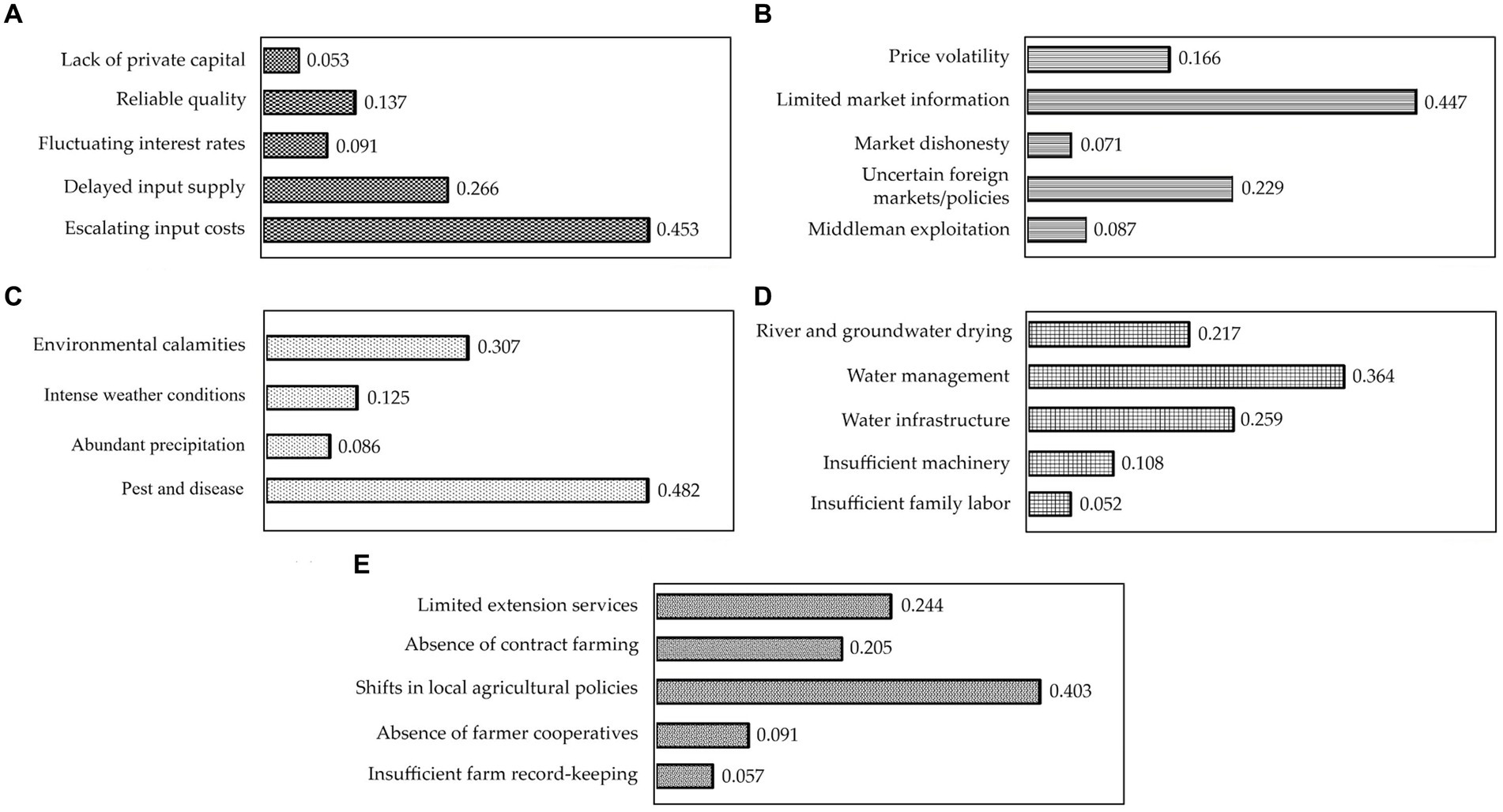
Figure 5. Fuzzy analytic hierarchy process-based prioritization of sub-risks using local weights. (A): Input-related risks, (B): Market-related risks, (C): External environmental risks, (D): Resource-related risks, (E): Policy and support-related risks.
Similarly, sub-section C concerns’ external environmental risks’, arranged from least to most crucial. It reveals the hierarchy with ‘abundant precipitation’ ranked at 0.086, ‘intense weather’ conditions at 0.125, ‘environmental calamities’ at 0.307, and ‘pest and disease’ at 0.482, outlining the gradation of importance within these environmental sub-risks. Moreover, sub-section D deals with ‘resource-related risks’ and presents a thorough arrangement in ascending order based on importance. Here, ‘insufficient family labor’ holds a weightage of 0.052, ‘insufficient machinery’ at 0.108, ‘river and groundwater drying’ at 0.217, ‘water infrastructure’ at 0.259, and ‘water management’ at 0.364. Lastly, sub-section E delves into ‘policy and support-related risks,’ where the sub-risks are intricately organized in ascending order of importance. ‘Insufficient farm record-keeping’ stands at 0.057, followed by ‘absence of farmer cooperatives’ at 0.091, ‘absence of contract farming’ at 0.205, ‘limited extension services’ at 0.244, and ‘shifts in local agricultural policies’ at 0.403, indicating the gradation of significance within this domain.
5.2.3 Overall prioritization of sub-risks using global weights
Using their global weights, sub-risks were hierarchically ranked as shown in Table 3. Sub-risk of ‘water management’ was ranked first at 0.239 followed by ‘pest and disease’ at 0.142 and escalating input costs at 0.083.
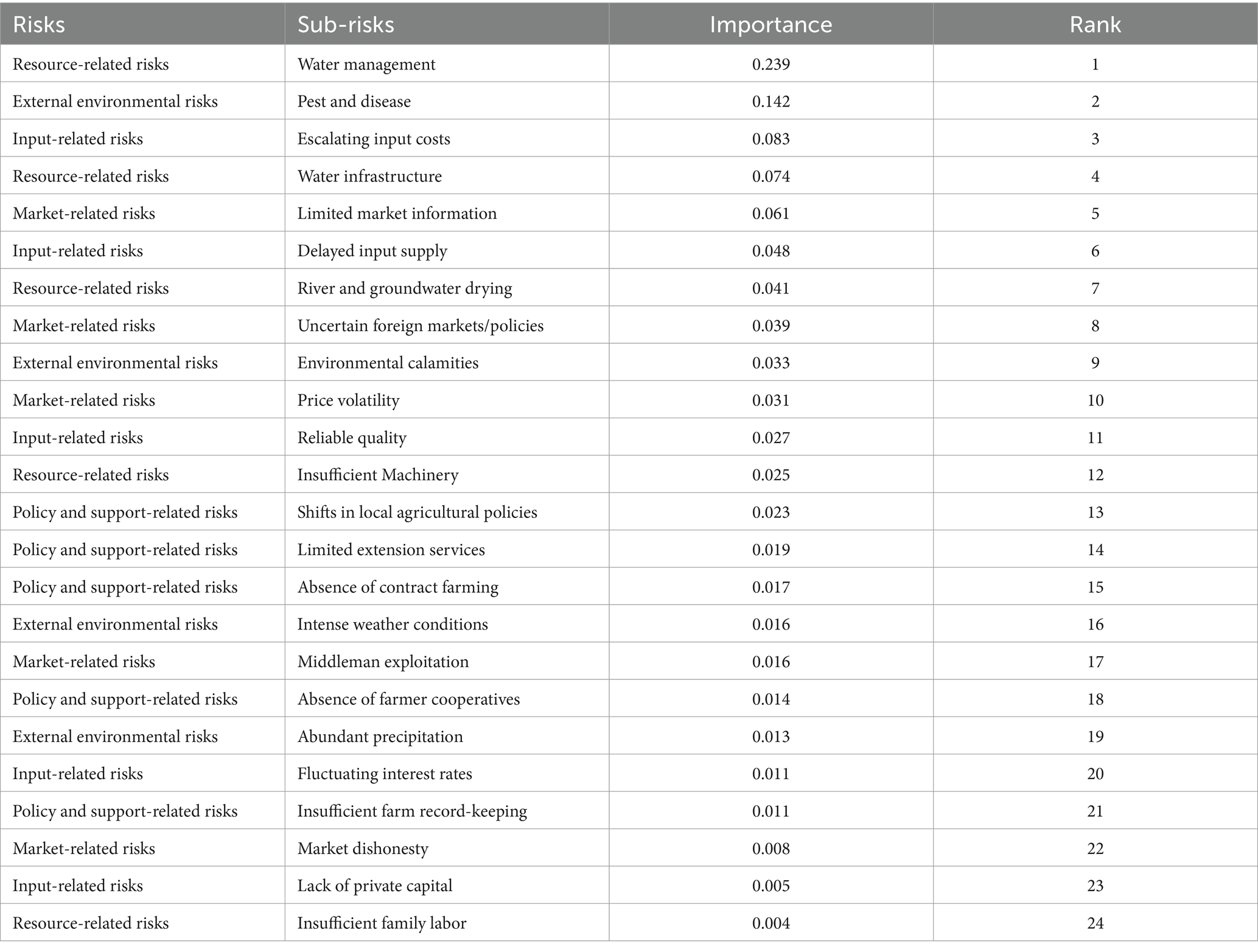
Table 3. Fuzzy analytic hierarchy process-based overall prioritization of sub-risks using global weights.
5.3 IPA results
5.3.1 Prioritization of main risks using local weights
Among the main risks, ‘external environmental risks’ stood at 4.324, followed closely by ‘policy and support-related risks’ at 4.213. Resource-related risks were ranked at 3.451, while market-related risks and input-related risks were ranked at 3.382 and 3.076, respectively, as outlined in Table 4.
5.3.2 Prioritization of sub-risks using local weights
IPA-based prioritization of sub-risks using local weights is given in Figure 6. In sub-section A, the hierarchical performance of sub-risks within input-related risks is given. Notably, ‘delayed input supply’ stood first, securing a score of 4.638, closely followed by ‘escalating input costs’ at 4.364. Subsequently, ‘reliable quality’ showcased a performance of 3.872, while ‘fluctuating interest rates’ and ‘lack of private capital’ registered scores of 3.519 and 3.401, respectively. Furthermore, the comprehensive evaluation of ‘market-related risks’ within sub-section B illustrated the relative performances of the respective sub-risks. ‘Price volatility’ stood out prominently with a notable score of 4.821, closely pursued by ‘middleman exploitation’ at 4.083. ‘Market dishonesty’ demonstrated a performance of 3.834, whereas ‘uncertain foreign markets/policies’ and ‘limited market information’ obtained scores of 3.627 and 3.117, correspondingly.
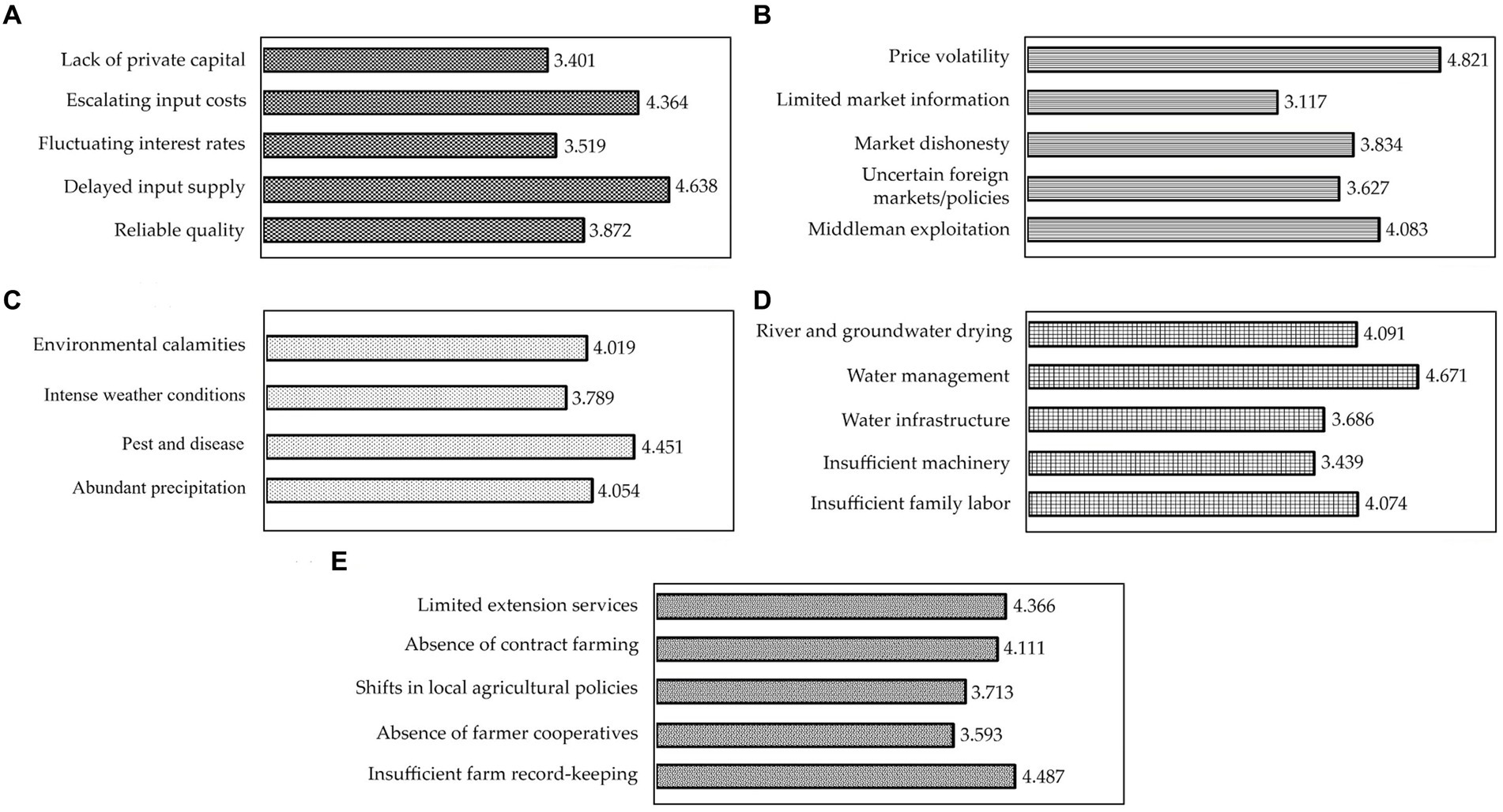
Figure 6. Importance performance analysis-based prioritization of sub-risks using local weights. (A): Input-related risks, (B): Market-related risks, (C): External environmental risks, (D): Resource-related risks, (E): Policy and support-related risks.
Moreover, sub-section C provided insight into the ranking of ‘external environmental risks’ sub-risks. ‘Pest and disease’ led with a significant score of 4.451, followed by ‘abundant precipitation’ at 4.054. ‘Environmental calamities’ displayed a performance of 4.019, while ‘intense weather conditions’ registered a score of 3.789, highlighting their respective performances within this category. Similarly, the performance evaluation within sub-section D examined the ordered performance of ‘resource-related risks’ sub-risks. ‘Water management’ scored 4.671, leading the performance rankings, followed by ‘river and groundwater drying’ at 4.091. ‘Insufficient family labor’ demonstrated performance of 4.074, ‘Water infrastructure’ exhibited a score of 3.686, and ‘in-sufficient machinery’ secured a score of 3.439, outlining their varying performances within this domain. Additionally, in sub-section E, the assessment delineated the performance rankings of ‘policy and support-related risk’ sub-risks. ‘Insufficient farm record-keeping’ led with a remarkable score of 4.487, while ‘limited extension services’ secured the second position with a score of 4.366. ‘Absence of contract farming’ followed closely with a score of 4.111, whereas ‘shifts in local agricultural policies’ attained a performance of 3.713. ‘Absence of farmer cooperatives’ ranked fifth with a score of 3.593.
5.3.3 Quadrant analysis
The quadrant analysis depicted in Figure 7 and Table 5 reveals certain sub-risks that not only signify considerable importance but also showcase a commendable level of performance. These sub-risks, such as ‘insufficient family labor,’ ‘limited extension services,’ ‘environmental calamities,’ ‘middleman exploitation,’ and ‘delayed input supply,’ emerged as significant in both aspects, quadrant 2. However, contrasting these, certain sub-risks portrayed substantial importance but exhibited relatively lower performance levels. This group included ‘water management,’ ‘river and groundwater drying,’ ‘absence of contract farming,’ ‘insufficient farm record-keeping,’ ‘pest and disease,’ ‘abundant precipitation,’ ‘price volatility,’ and ‘escalating input costs’, quadrant 1. Moreover, another set of sub-risks demonstrated limited significance while concurrently displaying decreased performance levels. Sub-risks such as ‘water infrastructure,’ ‘absence of farmer cooperatives,’ ‘intense weather conditions,’ ‘limited market information,’ ‘market dishonesty,’ and ‘lack of private capital’ fell within this category, quadrant 3. While evaluating sub-risks based on their importance and performance, a specific subset of sub-risks illustrated a disparity—showcasing a low degree of importance despite excelling in their performance. These sub-risks comprised ‘insufficient machinery,’ ‘shifts in local agricultural policies,’ ‘uncertain foreign markets/policies,’ ‘reliable quality,’ and ‘fluctuating interest rates’, quadrant 4.
6 Discussion
According to the findings of this study, a key observation is the recognition of the main risks within Pakistan’s rice farming, notably revolving around resource-related risks and external environmental risks. These risks, precisely identified through the fuzzy AHP and IPA, emphasize the critical management of sub-risks of water management and pest and disease. Published literature supports this finding (Alam et al., 2016; Janjua et al., 2021). Moreover, the quadrant analysis conducted through IPA further accentuates the significance of certain sub-risks positioned in quadrant 1 — a representation of high importance paired with low performance. This study also found that most of the published literature is biased towards studying specific types of risks. On the other hand, many sub-risks positioned in quadrant 1, particularly insufficient farm –record-keeping, abundant precipitation, and escalating input costs, are rarely mentioned in the published literature. This is a clear representation of the fact that rice farming risks are not comprehensively reported in the published literature. Additionally, there is no comparative assessment of rice farming risks in Pakistan, making effective management impossible. There was a majority of respondents, 83%, who thought the perception of agricultural risks was low. They blamed insufficient education and lack of capacity building for the situation. 75% of respondents expressed low levels of risk communication and suggested an effective training system for strengthening rice farming in Pakistan (see Table 6).
Survey respondents considered water management as the most significant risk to rice farming in Pakistan and should be the top priority for management. Published literature supports this finding (Muzammil et al., 2020). There are several reasons for this perception. According to one estimate, around 60% of the total available water in Pakistan is wasted on the way to irrigation fields due to poor irrigation systems (Qamar et al., 2018). Moreover, rainfall and surface water also need to meet the demands of water-intensive crops like rice (Qureshi et al., 2010). Thus, groundwater is heavily relied on for irrigation purposes (Sarwar and Eggers, 2006; Cheema et al., 2014). Excessive groundwater use in Punjab, however, causes the groundwater table to lower, reaching deeper levels below the soil surface. Another issue is rising levels of salinity in water, making it unsuitable for agricultural purposes. Water quality issues are rapidly increasing, and 23% of the farmed area in Punjab is facing this issue (Qureshi et al., 2010). Considering the ongoing water management regime and available water resources, some studies estimate that by 2035, Pakistan is likely to face acute shortages of water (<500 m3/capita/year) (Hassan et al., 2019; Muzammil et al., 2020). Since water management issues directly affect food security, therefore it is of utmost importance to resolve these problems through effective management. This would help to ensure food security, SDG 2.
In recent years, authorities have planned to implement diverse strategies such as deficit irrigation (Galindo et al., 2018), drought-resistant agriculture (Hu and Xiong, 2014), the use of technology (Evans and Sadler, 2008), conservation tillage (Ali A. B. et al., 2017; Ali S. et al., 2017), and soil mulching (Kader et al., 2019) to improve water management in Pakistan. However, more than the pace and scale of these traditional policies are needed to bring fruitful results. Studies suggest the use of a more efficient and advanced water management strategy, i.e., water footprint in Pakistan (Muzammil et al., 2020). This management strategy has proven to be very successful in many countries of the world, including China (Cao et al., 2021). Another suitable option for better water management in Pakistan is the optimization of cropping patterns. It is estimated that through this strategy, up to 35% of water can be saved (Muzammil et al., 2020). The use of cropping patterns to mitigate water management risk is evidenced in available online literature (Zeng et al., 2012; Ghasemi et al., 2014).
Moreover, improvements in irrigation technologies have the potential to reduce water consumption by up to 23%. Several studies strongly suggest the use of irrigation technology (Maisiri et al., 2005; Liu et al., 2013). However, despite efforts, the use of irrigation technology has failed consistently in Pakistan (Qureshi and Perry, 2021). High input cost is the major reason for this happening (Qureshi et al., 2010). To strengthen the irrigation system in Punjab, the World Bank launched a subsidy-based project (PIPIP, 2012–2021) aimed at improving the irrigation system spanned over 50,000 hectares (Cheema et al., 2014). Such initiatives are crucial to enhancing the ongoing water management regime in Pakistan. Moreover, some researchers have suggested high water prices for irrigation to save water (Qamar et al., 2018). On the other hand, some propose low prices. Therefore, comprehensive research is needed to deal with water price formulation to reinforce water management in Pakistan.
According to the findings of this study, pest and disease risk is the second most significant risk affecting rice farming in Pakistan. The impact of this risk has been widely studied in the published research. Viral diseases such as yellow dwarf and tungro disease are transmitted through insects, resulting in substantial economic losses (Qamar et al., 2018). Major rice pests include Scirpophaga innotata (Lepidoptan stem borer) and S. incertulas. These pests significantly impact rice production quantity (Haider et al., 2020; Hajjar et al., 2023). It is said that around 20% of rice yield is reduced due to S. incertulas, S. innotata, Sesamia inferens (pink stem borer), and Chinailo suppressalis (striped stem borer) infestation in Punjab, Pakistan (Oh, 2001). To control pests, insecticides are used heavily. However, this results in the second infestation, which is driven by secondary insects such as Nilaparvata lugens (brown planthopper) (Li et al., 2023). In addition, some insects have turned into new pests of rice in Pakistan. During the past two decades, chemical control, hydrocarbons, and chlorinated compounds have been the most popular methods for regulating pest attacks in Pakistan (Tariq et al., 2007; Alam et al., 2016). Sometimes, biological control coupled with pest-resistant varieties of plants is used to encounter infestations. However, the use of integrated pest management could be more frequent in Pakistan. The main reasons for this happening include the need for more knowledge and resources.
Escalating input costs placed in quadrant 1 of the quadrant analysis are rarely reported as the significant risk confronting rice farming in Pakistan (Mottaleb and Mohanty, 2015). Input represents diverse factors of production, including labor, fertilizers, machinery, etc. Labor available to rice farming is decreasing sharply due to the various risks involved with agriculture and other available potential opportunities (Mohiuddin et al., 2020). Inflation in Pakistan makes it difficult for farmers to purchase fertilizers. With rice being highly water-intensive, significant costs, 20% of the total rice production value, only relate to its irrigation needs (Qamar et al., 2018). This situation is particularly critical for small-scale farmers, who need to be financially sound enough to bear high electricity and other machinery costs to irrigate their crops properly (Ahmed et al., 2017). Thus, small farmers are more likely prone to escalating input costs, which can quickly diminish their net profit and well-being. Therefore, to ensure food security, SDG 2, and urban resilience, it is essential to take measures that not only increase rice production but also preserve cultural practices associated with rice farming in Pakistan.
It is possible to propose several targeted mitigation strategies to address the identified risks confronted by rice farming in Pakistan. As a first step to mitigate input-related risks, which include challenges such as rising input costs and delays in supplies, farmers could form cooperative arrangements to purchase inputs in bulk, thus negotiating better prices and ensuring timely deliveries. Furthermore, improving access to reliable credit facilities would enable farmers to stabilize their financial plans in the face of fluctuating interest rates. Market-related risks, such as volatile prices and limited market information, can be reduced by enhancing farmer education programs and developing direct access to the market via electronic platforms. Moreover, agricultural extension services can help farmers address ‘external environmental risks,’ such as pest and disease outbreaks exacerbated by climate change (such as Alzahrani et al., 2023). In addition, advocacy for policy reforms that support long-term planning and investments in agricultural infrastructure, coupled with training programs to improve record-keeping practices, may enhance the sector’s resilience for ‘policy and support-related risks’.
7 Conclusion and policy recommendation
This study systematically ranks the risks confronted by rice farming in Pakistan based on their estimated importance. It finds that the sub-risks of water management, pest and disease, and escalating input costs should be the top management priority in Pakistan. Furthermore, it highlights a significant gap in the existing literature, which primarily focuses on specific types of risks, overlooking other crucial risk factors. Therefore, unexplored risks should be the focus of future studies for effective management. Moreover, the quadrant analysis conducted through IPA further accentuates the significance of certain sub-risks positioned in quadrant 1 — a representation of high importance paired with low performance. In line with SDG 2, the findings of this study can help ensure food security. The attainment of this goal is significant in Pakistan, where food security is a critical issue. To enhance the resilience of rice farming, stakeholders must engage in effective risk communication, capacity building, and policy implementation. This will ensure the attainment of SDG 2, resulting in a hunger-free world. Moreover, this study will inspire further scientific research on the interplay between agricultural risks and food security not only in Pakistan but also in many other countries with similar agricultural, geographical, and political landscapes.
7.1 Limitations, future directions, and implications
Although this study comprehensively studies risks faced by rice farming, it has some limitations. Data bias can result from sampling techniques such as snowball sampling. Moreover, the ranking of risks is based on the data collected from one province in Pakistan. Other regions may have different types of risks and their corresponding order. In addition, this study employs statistical models, fuzzy AHP, and IPA, which have many issues. Furthermore, this study does not explore the evolution and the relationship between individual risks. However, it must be noted that these limitations do not mean this study’s findings are not significant. Instead, limitations are characteristics of every research conducted. These limitations create opportunities for future research. Researching individual types of risks and their relationship is imperative to make more comprehensive management strategies. This can involve using other robust statistical methods and other sampling techniques. Moreover, the data sample size can be increased and may be collected from other rice-growing regions. Future studies should also discuss uncharted risks in the present literature. This study can guide policymakers and managers to formulate enhanced risk management strategies by focusing on critical risk factors. It also advocates for policy reforms addressing identified gaps, such as insufficient farm record-keeping and the absence of farmer cooperatives. Moreover, this study can help to build resilience in rice farming. It aligns interventions with SDG 2 (Zero Hunger) by addressing particularly market-related risks that affect food security. Last but not least, it facilitates the mitigation of economic losses due to management failures.
Data availability statement
The raw data supporting the conclusions of this article will be made available by the authors, without undue reservation.
Author contributions
MM: Conceptualization, Formal analysis, Writing – original draft. AM: Data curation, Project administration, Writing – original draft. MS: Investigation, Resources, Writing – review & editing. ZL: Data curation, Methodology, Writing – review & editing.
Funding
The author(s) declare that no financial support was received for the research, authorship, and/or publication of this article.
Conflict of interest
The authors declare that the research was conducted in the absence of any commercial or financial relationships that could be construed as a potential conflict of interest.
Publisher’s note
All claims expressed in this article are solely those of the authors and do not necessarily represent those of their affiliated organizations, or those of the publisher, the editors and the reviewers. Any product that may be evaluated in this article, or claim that may be made by its manufacturer, is not guaranteed or endorsed by the publisher.
Supplementary material
The Supplementary material for this article can be found online at: https://www.frontiersin.org/articles/10.3389/fsufs.2024.1404524/full#supplementary-material
References
Abbas, S., Kousar, S., Shirazi, S. A., Yaseen, M., and Latif, Y. (2022). Illuminating empirical evidence of climate change: impacts on rice production in the Punjab regions, Pakistan. Agric. Res. 11, 32–47. doi: 10.1007/s40003-021-00548-w
Ahmad, D., Afzal, M., and Rauf, A. (2020). Environmental risks among rice farmers and factors influencing their risk perceptions and attitudes in Punjab, Pakistan. Environ. Sci. Pollut. Res. 27, 21953–21964. doi: 10.1007/s11356-020-08771-8
Ahmad, Q. U. A., Biemans, H., Moors, E., Shaheen, N., and Masih, I. (2021). The impacts of climate variability on crop yields and irrigation water demand in South Asia. Water 13:50. doi: 10.3390/w13010050
Ahmad, M., and Farooq, U. (2010). The state of food security in Pakistan: future challenges and coping strategies. Pak. Dev. Rev. 49, 903–923.
Ahmad, B., Gjolberg, O., and Mehdi, M. (2017). Spatial differences in rice price volatility: a case study of Pakistan 1994-2011. Pak. Dev. Rev. 3, 265–289.
Ahmed, A., Iftikhar, H., and Chaudhry, G. M. (2007). Water resources and conservation strategy of Pakistan. Pak. Dev. Rev. 46, 997–1009.
Ahmed, U. I., Ying, L., Bashir, M. K., Abid, M., and Zulfiqar, F. (2017). Status and determinants of small farming households’ food security and role of market access in enhancing food security in rural Pakistan. PLoS One 12:e0185466. doi: 10.1371/journal.pone.0185466
Akhtar, S., Abbas, A., Iqbal, M. A., Rizwan, M., Samie, A., Faisal, M., et al. (2021). What determines the uptake of multiple tools to mitigate agricultural risks among hybrid maize growers in Pakistan? Findings from field-level data. Agriculture 11:578. doi: 10.3390/agriculture11070578
Akram, M. W., Akram, N., Wang, H., Andleeb, S., Rehman, K., Kashif, U., et al. (2020). Socioeconomics determinants to adopt agricultural machinery for sustainable organic farming in Pakistan: a multinomial Probit model. Sustain. For. 12:9806. doi: 10.3390/su12239806
Alam, M. Z., Haque, M. M., Islam, M. S., Hossain, E., Hasan, S. B., Hasan, S. B., et al. (2016). Comparative study of integrated pest management and farmers practices on sustainable environment in the rice ecosystem. Int. J. Zool. 2016, 1–12. doi: 10.1155/2016/7286040
Ali, M., Akram, M. M., Silverman, E., Habib, H. U., Mohsan, M., Ahmad, M., et al. (2022). On farm water management in Pakistan - an overview. Int. J. Water Res. Environ. 11, 52–56. doi: 10.5829/idosi.ijwres.2022.11.3.17112
Ali, A. B., Elshaikh, N. A., Hong, L., Adam, A. B., and Haofang, Y. (2017). Conservation tillage as an approach to enhance crops water use efficiency. Acta Agric. Scand. Sect. B Soil Plant Sci. 67, 252–262. doi: 10.1080/09064710.2016.1255349
Ali, S., Liu, Y., Ishaq, M., Shah, T., Abdullah, I., and Din, I. (2017). Climate change and its impact on the yield of major food crops: evidence from Pakistan. Food Secur. 6:39. doi: 10.3390/foods6060039
Ali, K., Wang, X., Riaz, M., Islam, B., Khan, Z. H., Shah, F., et al. (2019). Biochar: an eco-friendly approach to improve wheat yield and associated soil properties on sustainable basis. Pak. J. Bot. 51, 1255–1261. doi: 10.30848/PJB2019-4(7)
Alifu, H., Hirabayashi, Y., Imada, Y., and Shiogama, H. (2022). Enhancement of river flooding due to global warming. Sci. Rep. 12:20687. doi: 10.1038/s41598-022-25182-6
Alzahrani, K., Ali, M., Azeem, M. I., and Alotaibi, B. A. (2023). Efficacy of public extension and advisory services for sustainable rice production. Agriculture 13:1062. doi: 10.3390/agriculture13051062
Amir, S., Saqib, Z., Khan, M. I., Khan, M. A., Bokhari, S. A., Zaman-ul-Haq, M., et al. (2020). Farmers’ perceptions and adaptation practices to climate change in rain-fed area: a case study from district Chakwal, Pakistan. Pak. J. Agric. Sci. 57, 465–475. doi: 10.21162/PAKJAS/19.9030
Arman, H., Hadi-Vencheh, A., Arman, A., and Moslehi, A. (2021). Revisiting the approximated weight extraction methods in fuzzy analytic hierarchy process. Int. J. Intell. Syst. 36, 1644–1667. doi: 10.1002/int.22355
Armanda, D. T., Guinee, J. B., and Tukker, A. (2019). The second green revolution: innovative urban agriculture’s contribution to food security and sustainability – a review. Glob. Food Secur. 22, 13–24. doi: 10.1016/j.gfs.2019.08.002
Asghar, M., Arshad, M., Fiaz, M., Suhail, A., and Sabir, A. M. (2013). A survey of rice farmers’ farming practices posing threats to insect biodiversity of rice crop in the Punjab, Pakistan. Int. J. Biodivers. Conserv 5, 647–654. doi: 10.5897/IJBC11.199
Ashraf, S., and Hassan, Z. T. (2021). The challenges facing agricultural extension from the viewpoint of agricultural officers in Pakistan. J. Agr. Sci. Tech. 23, 499–513.
Ashraf, S., Saqib, R., Hassan, Z. Y., Luqman, M., and Rehman, A. (2020). Analysis of intermediaries’ influence in citrus supply chain in Pakistan. Sarhad J. Agric. 35, 210–216. doi: 10.17582/journal.sja/2020/36.1.210.216
Aslam, M. (2016). Agricultural productivity current scenario, constraints and future prospects in Pakistan. Sarhad J. Agric. 32, 289–303. doi: 10.17582/journal.sja/2016.32.4.289.303
Azzopardi, E., and Nash, R. (2013). A critical evaluation of importance–performance analysis. Tour. Manag. 35, 222–233. doi: 10.1016/j.tourman.2012.07.007
Babar, U., Nawaz, M. A., Arshad, U., Azhar, M. T., Atif, R. M., Golokhvast, K. S., et al. (2020). Transgenic crops for the agricultural improvement in Pakistan: a perspective of environmental stresses and the current status of genetically modified crops. GM Crops Food. 11, 1–29. doi: 10.1080/21645698.2019.1680078
Baloch, M. A., and Thapa, G. B. (2019). Review of the agricultural extension modes and services with the focus to Balochistan, Pakistan. J. Saudi Soc. Agri. Sci. 18, 188–194. doi: 10.1016/j.jssas.2017.05.001
Bashir, K., Khan, N. M., Rasheed, S., and Salim, M. (2007). Indica rice varietal development in Pakistan: an overview. Paddy Water Environ. 5, 73–81. doi: 10.1007/s10333-007-0073-y
Cao, X., Zeng, W., Wu, M., Li, T., Chen, S., and Wang, W. (2021). Water resources efficiency assessment in crop production from the perspective of water footprint. J. Clean. Prod. 309:127371. doi: 10.1016/j.jclepro.2021.127371
Chandio, A. A., Jiang, Y., Gessesse, A. T., and Dunya, R. (2019). The nexus of agricultural credit, farm size and technical efficiency in Sindh, Pakistan: a stochastic production frontier approach. J. Saudi Soc. Agric. Sci. 18, 348–354. doi: 10.1016/j.jssas.2017.11.001
Chandio, A. A., and Yuansheng, J. (2018). Determinants of adoption of improved rice varieties in northern Sindh, Pakistan. Rice Sci. 25, 103–110. doi: 10.1016/j.rsci.2017.10.003
Chartzoulakis, K., and Bertaki, M. (2015). Sustainable water management in agriculture under climate change. Agric. Agric. Sci. Proc. 4, 88–98. doi: 10.1016/j.aaspro.2015.03.011
Cheema, M. J. M., Immerzeel, W. W., and Bastiaanssen, W. G. M. (2014). Spatial quantification of groundwater abstraction in the irrigated Indus basin. Groundwater 52, 25–36. doi: 10.1111/gwat.12027
Dabbagh, M., Lee, S. P., and Parizi, R. M. (2016). Functional and non-functional requirements prioritization: empirical evaluation of IPA, AHP-based, and HAM-based approaches. Soft. Comput. 20, 4497–4520. doi: 10.1007/s00500-015-1760-z
Das, M., Das, A., and Pandey, R. (2022). Importance-performance analysis of ecosystem services in tribal communities of the Barind region, eastern India. Ecosyst. Serv. 55:101431. doi: 10.1016/j.ecoser.2022.101431
Deen, S. (2015). Pakistan 2010 floods. Policy gaps in disaster preparedness and response. Int. J. Disaster Risk Reduct. 12, 341–349. doi: 10.1016/j.ijdrr.2015.03.007
Demont, M. (2013). Reversing urban bias in African rice markets: a review of 19 national rice development strategies. Glob. Food Secur. 2, 172–181. doi: 10.1016/j.gfs.2013.07.001
Din, I. U., Muhammad, S., and Rehman, I. U. (2023). Heavy metal(loid)s contaminations in soils of Pakistan: a review for the evaluation of human and ecological risks assessment and spatial distribution. Environ. Geochem. Health 45, 1991–2012. doi: 10.1007/s10653-022-01312-x
Dorosh, P., Malik, S. J., and Krausova, M. (2010). Rehabilitating agriculture and promoting food security after the 2010 Pakistan floods: insights from the south Asian experience. Pak. Dev. Rev. 49, 167–192.
Duong, T. T., Brewer, T., Luck, J., and Zander, K. (2019). A global review of farmers’ perceptions of agricultural risks and risk management strategies. Agriculture 9:10. doi: 10.3390/agriculture9010010
Elahi, E., Abid, M., Zhang, L., Ul Haq, S., and Sahito, J. G. M. (2018). Agricultural advisory and financial services; farm level access, outreach and impact in a mixed cropping district of Punjab, Pakistan. Land Use Policy 71, 249–260. doi: 10.1016/j.landusepol.2017.12.006
Ellis, F. (2000). The determinants of rural livelihood diversification in developing countries. J. Agric. Econ. 51, 289–302. doi: 10.1111/j.1477-9552.2000.tb01229.x
Evans, R. G., and Sadler, E. J. (2008). Methods and technologies to improve efficiency of water use. Water Resour. Res. 44, 1–15. doi: 10.1029/2007WR006200
Fahad, S., and Wang, J. (2018). Farmers’ risk perception, vulnerability, and adaptation to climate change in rural Pakistan. Land Use Policy 79, 301–309. doi: 10.1016/j.landusepol.2018.08.018
Farooqui, S. Z. (2014). Prospects of renewables penetration in the energy mix of Pakistan. Renew. Sust. Energ. Rev. 29, 693–700. doi: 10.1016/j.rser.2013.08.083
Foreign Agriculture Service (2023). Pakistan: Rice production U.S. Department of Agriculture. Available online at: https://ipad.fas.usda.gov/countrysummary/?id=PK&crop=Rice (Accessed September 11, 2023).
Furlan, L., Vasileiadis, V. P., Chiarini, F., Huiting, H., Leskovsek, R., Razinger, J., et al. (2017). Risk assessment of soil-pest damage to grain maize in Europe within the framework of integrated Pest management. Crop Prot. 97, 52–59. doi: 10.1016/j.cropro.2016.11.029
Galindo, A., Collado-Gonzalez, J., Grinan, I., Corell, M., Centeno, A., Martin-Palomo, M. J., et al. (2018). Deficit irrigation and emerging fruit crops as a strategy to save water in Mediterranean semiarid agrosystems. Agric. Water Manag. 202, 311–324. doi: 10.1016/j.agwat.2017.08.015
Gaurav, K., Sinha, R., and Panda, P. K. (2011). The Indus flood of 2010 in Pakistan: a perspective analysis using remote sensing data. Nat. Hazards 59, 1815–1826. doi: 10.1007/s11069-011-9869-6
Ghani, H. U., Mahmood, A., Finkbeiner, M., Kaltschmitt, M., and Gheewala, S. H. (2023). Evaluating the absolute eco-efficiency of food products: a case study of rice in Pakistan. Environ. Impact Assess. Rev. 101:107119. doi: 10.1016/j.eiar.2023.107119
Ghasemi, M. M., Karamouz, M., and Shui, L. T. (2014). Distributed versus lumped optimization of cropping pattern and water resources utilization. Agric. Sci. 5, 257–269. doi: 10.4236/as.2014.54029
Giannakis, E., and Bruggeman, A. (2015). The highly variable economic performance of European agriculture. Land Use Policy 45, 26–35. doi: 10.1016/j.landusepol.2014.12.009
Gopalakrishnan, T., Hasan, M. K., Haque, A. S., Jayasinghe, S. L., and Kumar, L. (2019). Sustainability of coastal agriculture under climate change. Sustain. For. 11:7200. doi: 10.3390/su11247200
Gul, A., Xiumin, W., Chandio, A. A., Rehman, A., Siyal, S. A., and Asare, I. (2022). Tracking the effect of climatic and non-climatic elements on rice production in Pakistan using the ARDL approach. Environ. Sci. Pollut. Res. 29, 31886–31900. doi: 10.1007/s11356-022-18541-3
Haider, I., Akhtar, M., Noman, A., and Qasim, M. (2020). Population trends of some insect pests of rice crop on light trap and its relation to abiotic factors in Punjab Pakistan. Pak. J. Zool. 53, 1015–1023. doi: 10.17582/journal.pjz/20190822060844
Hajjar, M. J., Ahmed, N., Alhudaib, K. A., and Ullah, H. (2023). Integrated insect pest management techniques for rice. Sustain. For. 15:4499. doi: 10.3390/su15054499
Hanif, M. A., Islam, M. M., and Ahmed, M. B. (2020). Factors affecting rural-urban migration of agricultural laborers. Fundam. Appl. Agric. 5, 1–123. doi: 10.5455/faa.78035
Hassan, S. Z., Jajja, M. S. S., Asif, M., and Foster, G. (2021). Bringing more value to small farmers: a study of potato farmers in Pakistan. Manag. Decis. 59, 829–857. doi: 10.1108/MD-12-2018-1392
Hassan, D., Rais, M. N., Ahmed, W., Bano, R., Burian, S. J., Ijaz, M. W., et al. (2019). Future water demand modeling using water evaluation and planning: a case study of the Indus Basin in Pakistan. Sustain. Water Resour. Manag. 5, 1903–1915. doi: 10.1007/s40899-019-00343-0
Hu, H., and Xiong, L. (2014). Genetic engineering and breeding of drought-resistant crops. Ann. Rev. Plant Biol. 65, 715–741. doi: 10.1146/annurev-arplant-050213-040000
Hussain, A., Akhtar, W., and Jabbar, A. (2022). Risk management for small farmers in Pakistan: a review. Pak. J. Agri. Sci. 59, 247–259. doi: 10.21162/PAKJAS/22.334
Hussain, M., and Mumtaz, S. (2014). Climate change and managing water crisis: Pakistan’s perspective. Rev. Environ. Health 29, 71–77. doi: 10.1515/reveh-2014-0020
Ijaz, M., and Goheer, M. A. (2021). Emission profile of Pakistan’s agriculture: past trends and future projections. Environ. Dev. Sustain. 23, 1668–1687. doi: 10.1007/s10668-020-00645-w
Jamro, S., Dars, G. H., Ansari, K., and Krakauer, N. Y. (2019). Spatio-temporal variability of drought in Pakistan using standardized precipitation evapotranspiration index. Appl. Sci. 9:4588. doi: 10.3390/app9214588
Janjua, S., Hassan, I., Muhammad, S., Ahmed, S., and Ahmed, A. (2021). Water management in Pakistan’s Indus Basin: challenges and opportunities. Water Policy 23, 1329–1343. doi: 10.2166/wp.2021.068
Kader, M. A., Singha, A., Begum, M. A., Jewel, A., Khan, F. H., and Khan, N. I. (2019). Mulching as a water-saving technique in dryland agriculture: review article. Bull. Natl. Res. Cent. 43:147. doi: 10.1186/s42269-019-0186-7
Kalogiannidis, S., Kalfas, D., Chatzitheodoridis, F., and Papaevangelou, O. (2022). Role of crop-protection technologies in sustainable agricultural productivity and management. Land 11:1680. doi: 10.3390/land11101680
Khan, H. H., Malik, M. N., Konecna, Z., Chofreh, A. G., Goni, F. A., and Klemes, J. J. (2022). Block chain technology for agricultural supply chains during the COVID-19 pandemic: benefits and cleaner solutions. J. Clean. Prod. 347:131268. doi: 10.1016/j.jclepro.2022.131268
Khan, N. A., Qiao, J., Abid, M., and Gao, Q. (2021). Understanding farm-level cognition of and autonomous adaptation to climate variability and associated factors: evidence from the rice-growing zone of Pakistan. Land Use Policy 105:105427. doi: 10.1016/j.landusepol.2021.105427
Khandker, S. R., and Faruqee, R. R. (2003). The impact of farm credit in Pakistan. Agric. Econ. 28, 197–213. doi: 10.1111/j.1574-0862.2003.tb00138.x
Khumairoh, U., Lantinga, E. A., Schulte, R. P., Suprayogo, D., and Groot, J. C. (2018). Complex rice systems to improve rice yield and yield stability in the face of variable weather conditions. Sci. Rep. 8:14746. doi: 10.1038/s41598-018-32915-z
Kim, Y. U., Webber, H., Adiku, S. G., Junior, R. D. S. N., Deswarte, J. C., Asseng, S., et al. (2024). Mechanisms and modelling approaches for excessive rainfall stress on cereals: waterlogging, submergence, lodging, pests and diseases. Agric. For. Meteorol. 344:109819. doi: 10.1016/j.agrformet.2023.109819
Komarek, A. M., De Pinto, A., and Smith, V. H. (2020). A review of types of risks in agriculture: what we know and what we need to know. Agric. Syst. 178:102738. doi: 10.1016/j.agsy.2019.102738
Leung, L. C., and Cao, D. (2000). On consistency and ranking of alternatives in fuzzy AHP. Eur. J. Oper. Res. 124, 102–113. doi: 10.1016/S0377-2217(99)00118-6
Li, H., Liu, Y., Zhao, X., Zhang, L., and Yuan, K. (2021). Estimating effects of cooperative membership on farmers’ safe production behaviors: evidence from the rice sector in China. Environ. Sci. Pollut. Res. 28, 25400–25418. doi: 10.1007/s11356-020-12337-z
Li, M., Xu, Y., Guo, J., Li, Y., and Li, W. (2020). Application of a GIS-based fuzzy multi-criteria evaluation approach for wind farm site selection in China. Energies 13:2426. doi: 10.3390/en13102426
Li, H., Xu, L., Wu, W., Peng, W., Lou, Y., and Lu, J. (2023). Infestation by the piercing–sucking herbivore Nilaparvata lugens systemically triggers JA-and SA-dependent defense responses in rice. Biology 12:820. doi: 10.3390/biology12060820
Lin, C. N. (2020). A fuzzy analytic hierarchy process-based analysis of the dynamic sustainable management index in leisure agriculture. Sustain. For. 12:5395. doi: 10.3390/su12135395
Liu, H.-J., Kang, Y., Yao, S.-M., Sun, Z.-Q., Liu, S.-P., and Wang, Q.-G. (2013). Field evaluation on water productivity of winter wheat under sprinkler or surface irrigation in the North China plain. Irrig. Drain. 62, 37–49. doi: 10.1002/ird.1712
Lunt, T., Jones, A. W., Mulhern, W. S., Lezaks, D. P., and Jahn, M. M. (2016). Vulnerabilities to agricultural production shocks: an extreme, plausible scenario for assessment of risk for the insurance sector. Clim. Risk Manag. 13, 1–9. doi: 10.1016/j.crm.2016.05.001
Mahabadi, N. Y., and Soltani, S. M. (2021). Applicability of fuzzy and fuzzy analytic hierarchy process (fuzzy AHP) methods to determine the optimum soil depth in land suitability evaluation for irrigated rice. Pol. J. Soil Sci. 54, 103–122. doi: 10.17951/pjss.2021.54.1.103-122
Maisiri, N., Senzanje, A., Rockstrom, J., and Twomlow, S. J. (2005). On farm evaluation of the effect of low cost drip irrigation on water and crop productivity compared to conventional surface irrigation system. Phys. Chem. Earth Parts ABC 30, 783–791. doi: 10.1016/j.pce.2005.08.021
Mastoi, T. A., Mastoi, Z. A., Khetran, Z. A., Alizai, G. H., Baig, B., Khan, M., et al. (2021). Impact of micro finance on the agricultural development in Balochistan, Pakistan. Sarhad J. Agric. 37, 484–491. doi: 10.17582/journal.sja/2021/37.2.484.491
Mazhar, R., Ghafoor, A., Xuehao, B., and Wei, Z. (2021). Fostering sustainable agriculture: do institutional factors impact the adoption of multiple climate-smart agricultural practices among new entry organic farmers in Pakistan? J. Clean. Prod. 283:124620. doi: 10.1016/j.jclepro.2020.124620
Mazhar, R., Xuehao, B., Dogot, T., Skominas, R., Tanaskovik, V., Azadi, H., et al. (2022). Contract farming and technical efficiency: a case of export-oriented organic rice farmers in Pakistan. Land 11:1953. doi: 10.3390/land11111953
Mohiuddin, I., Kamran, M. A., Jalilov, S. M., Ahmad, M. U. D., Adil, S. A., Ullah, R., et al. (2020). Scale and drivers of female agricultural labor: evidence from Pakistan. Sustain. For. 12:6633. doi: 10.3390/su12166633
Mohsin, M., Hengbin, Y., Luyao, Z., Rui, L., Chong, Q., and Mehak, A. (2022). An application of multiple-criteria decision analysis for risk prioritization and management: a case study of the fisheries sector in Pakistan. Sustain. For. 14:8831. doi: 10.3390/su14148831
Mottaleb, K. A., and Mohanty, S. (2015). Farm size and profitability of rice farming under rising input costs. J. Land Use Sci. 10, 243–255. doi: 10.1080/1747423X.2014.919618
Mukhtar, U., Zhong, Z., Tian, B., Razzaq, A., Naseer, M. A. U. R., and Hina, T. (2018). Does rural-urban migration improve employment quality and household welfare? Evidence from Pakistan. Sustain. For. 10:4281. doi: 10.3390/su10114281
Muzammil, M., Zahid, A., and Breuer, L. (2020). Water resources management strategies for irrigated agriculture in the Indus Basin of Pakistan. Water 12:1429. doi: 10.3390/w12051429
Oh, H. (2001). Revisiting importance–performance analysis. Tour. Manag. 22, 617–627. doi: 10.1016/S0261-5177(01)00036-X
Otsuka, K. (2013). Food insecurity, income inequality, and the changing comparative advantage in world agriculture. Agric. Econ. 44, 7–18. doi: 10.1111/agec.12046
Ozkan, B., Dengiz, O., and Demirag Turan, I. (2019). Site suitability assessment and mapping for rice cultivation using multi-criteria decision analysis based on fuzzy-AHP and TOPSIS approaches under semihumid ecological condition in delta plain. Paddy Water Environ. 17, 665–676. doi: 10.1007/s10333-019-00692-8
Panno, S., Davino, S., Caruso, A. G., Bertacca, S., Crnogorac, A., Mandic, A., et al. (2021). A review of the most common and economically important diseases that undermine the cultivation of tomato crop in the mediterranean basin. Agronomy 11:2188. doi: 10.3390/agronomy11112188
Qamar, M. U., Azmat, M., Abbas, A., Usman, M., Shahid, M. A., and Khan, Z. M. (2018). Water pricing and implementation strategies for the sustainability of an irrigation system: a case study within the command area of the Rakh Branch Canal. Water 10:509. doi: 10.3390/w10040509
Qingwen, M., Bojie, W., and Yehong, S. (2022). Progresses and perspectives of the resource evaluation related to agricultural heritage tourism. J. Resour. Ecol. 13, 708–719. doi: 10.5814/j.issn.1674-764x.2022.04.016
Qureshi, M. R. N. M., Almuflih, A. S., Sharma, J., Tyagi, M., Singh, S., and Almakayeel, N. (2022). Assessment of the climate-smart agriculture interventions towards the avenues of sustainable production–consumption. Sustain. For. 14:8410. doi: 10.3390/su14148410
Qureshi, A. S., McCornick, P. G., Sarwar, A., and Sharma, B. R. (2010). Challenges and prospects of sustainable groundwater management in the Indus basin, Pakistan. Water Resour. Manag. 24, 1551–1569. doi: 10.1007/s11269-009-9513-3
Qureshi, A. S., and Perry, C. (2021). Managing water and salt for sustainable agriculture in the Indus Basin of Pakistan. Sustain. For. 13:5303. doi: 10.3390/su13095303
Rabbi, F., Ahamad, R., Ali, S., Chandio, A. A., Ahmad, W., Ilyas, A., et al. (2019). Determinants of commercialization and its impact on the welfare of smallholder rice farmers by using Heckman’s two-stage approach. J. Saudi Soc. Agric. Sci. 18, 224–233. doi: 10.1016/j.jssas.2017.06.001
Ranji, A., Parashkoohi, M. G., Zamani, D. M., and Ghahderijani, M. (2022). Evaluation of agronomic, technical, economic, and environmental issues by analytic hierarchy process for rice weeding machine. Energy Rep. 8, 774–783. doi: 10.1016/j.egyr.2021.12.028
Raza, M. H., Khan, G. A., Shahbaz, B., and Saleem, M. F. (2020). Effectiveness of information and communication technologies as information source among farmers in Pakistan. Pak. J. Agric. Sci. 57, 281–288. doi: 10.21162/PAKJAS/19.8292
Raza, A., Tong, G., Sikandar, F., Erokhin, V., and Tong, Z. (2023). Financial literacy and credit accessibility of rice farmers in Pakistan: analysis for Central Punjab and Khyber Pakhtunkhwa regions. Sustain. For. 15:2963. doi: 10.3390/su15042963
Rehman, A., Jingdong, L., Chandio, A. A., Shabbir, M., and Hussain, I. (2017). Economic outlook of rice crops in Pakistan: a time series analysis (1970–2015). Financ. Innov. 3, 1–9. doi: 10.1186/s40854-017-0063-z
Rizwan, M., Ping, Q., Saboor, A., Ahmed, U. I., Zhang, D., Deyi, Z., et al. (2020). Measuring rice farmers’ risk perceptions and attitude: evidence from Pakistan. Hum. Ecol. Risk. Assess. 26, 1832–1847. doi: 10.1080/10807039.2019.1602753
Ruhinduka, R. D., Alem, Y., Eggert, H., and Lybbert, T. (2020). Smallholder rice farmers’ post-harvest decisions: preferences and structural factors. Eur. Rev. Agric. Econ. 47, 1587–1620. doi: 10.1093/erae/jbz052
Saaty, T. L. (1977). A scaling method for priorities in hierarchical structures. J. Math. Psychol. 15, 234–281. doi: 10.1016/0022-2496(77)90033-5
Saaty, T. L. (2005). Making and validating complex decisions with the AHP/ANP. J. Syst. Sci. Syst. Eng. 14, 1–36. doi: 10.1007/s11518-006-0179-6
Sahin, B., and Yip, T. L. (2017). Shipping technology selection for dynamic capability based on improved Gaussian fuzzy AHP model. Ocean Eng. 136, 233–242. doi: 10.1016/j.oceaneng.2017.03.032
Saqib, S. E., Ahmad, M. M., Panezai, S., and Rana, I. A. (2016). An empirical assessment of farmers’ risk attitudes in flood-prone areas of Pakistan. Int. J. Disaster Risk Reduct. 18, 107–114. doi: 10.1016/j.ijdrr.2016.06.007
Saqib, S. E., Kuwornu, J. K., Ahmad, M. M., and Panezai, S. (2018). Subsistence farmers’ access to agricultural credit and its adequacy: some empirical evidences from Pakistan. Int. J. Soc. Econ. 45, 644–660. doi: 10.1108/IJSE-12-2016-0347
Sardar, A., Kiani, A. K., and Kuslu, Y. (2021). Does adoption of climate-smart agriculture (CSA) practices improve farmers’ crop income? Assessing the determinants and its impacts in Punjab province, Pakistan. Environ. Dev. Sustain. 23, 10119–10140. doi: 10.1007/s10668-020-01049-6
Sarwar, A., and Eggers, H. (2006). Development of a conjunctive use model to evaluate alternative management options for surface and groundwater resources. Hydrogeol. J. 14, 1676–1687. doi: 10.1007/s10040-006-0066-8
Sever, I. (2015). Importance-performance analysis: a valid management tool? Tour. Manag. 48, 43–53. doi: 10.1016/j.tourman.2014.10.022
Shah, A., Ali, M., Ali, K., Ahmed, M., and Tan, J. (2022). Assessing water and water infrastructure quality in community-managed water supply systems in northern Pakistan. Water Pract. Technol. 17, 1046–1057. doi: 10.2166/wpt.2022.053
Sharif, A. (2011). Technical adaptations for mechanized SRI production to achieve water saving and increased profitability in Punjab, Pakistan. Paddy Water Environ. 9, 111–119. doi: 10.1007/s10333-010-0223-5
Sipahi, S., and Timor, M. (2010). The analytic hierarchy process and analytic network process: an overview of applications. Manag. Deci. 48, 775–808. doi: 10.1108/00251741011043920
Skendzic, S., Zovko, M., Zivkovic, I. P., Lesic, V., and Lemic, D. (2021). The impact of climate change on agricultural insect pests. Insects 12:440. doi: 10.3390/insects12050440
Spielman, D. J., and Kennedy, A. (2016). Towards better metrics and policymaking for seed system development: insights from Asia’s seed industry. Agric. Syst. 147, 111–122. doi: 10.1016/j.agsy.2016.05.015
Subramanian, N., and Ramanathan, R. (2012). A review of applications of analytic hierarchy process in operations management. Int. J. Prod. Econ. 138, 215–241. doi: 10.1016/j.ijpe.2012.03.036
Tariq, M. I., Afzal, S., Hussain, I., and Sultana, N. (2007). Pesticides exposure in Pakistan: a review. Environ. Int. 33, 1107–1122. doi: 10.1016/j.envint.2007.07.012
Tudi, M., Daniel Ruan, H., Wang, L., Lyu, J., Sadler, R., Connell, D., et al. (2021). Agriculture development, pesticide application and its impact on the environment. Int. J. Environ. Res. Public Health 18:1112. doi: 10.3390/ijerph18031112
Ullah, R., Shivakoti, G. P., and Ali, G. (2015). Factors affecting farmers’ risk attitude and risk perceptions: the case of Khyber Pakhtunkhwa, Pakistan. Int. J. Disaster Risk Reduct. 13, 151–157. doi: 10.1016/j.ijdrr.2015.05.005
Usman, M., Ali, A., Hassan, S., and Bashir, M. K. (2022). Farmers’ perception regarding natural hazards and impact on food productivity: evidence from rice-wheat cropping zone of Punjab, Pakistan. Pak. J. Agric. Sci. 59, 147–156. doi: 10.21162/PAKJAS/22.376
Wind, Y., and Saaty, T. L. (1980). Marketing applications of the analytic hierarchy process. Manag. Sci. 26, 641–658. doi: 10.1287/mnsc.26.7.641
Wu, C. K., Wang, C. N., and Le, T. K. T. (2022). Fuzzy multi criteria decision making model for agritourism location selection: a case study in Vietnam. Axioms 11:176. doi: 10.3390/axioms11040176
Yadav, V. S., Singh, A. R., Gunasekaran, A., Raut, R. D., and Narkhede, B. E. (2022). A systematic literature review of the agro-food supply chain: challenges, network design, and performance measurement perspectives. Sustain. Prod. Consum. 29, 685–704. doi: 10.1016/j.spc.2021.11.019
Yager, R. R. (2003). A procedure for ordering fuzzy subsets of the unit interval. J. Inf. Sci. 24, 143–161. doi: 10.1016/0020-0255(81)90017-7
Yasin, H. Q., Breadsell, J., and Tahir, M. N. (2021). Climate-water governance: a systematic analysis of the water sector resilience and adaptation to combat climate change in Pakistan. Water Policy 23, 1–35. doi: 10.2166/wp.2020.113
Zeng, Z., Liu, J., Koeneman, P. H., Zarate, E., and Hoekstra, A. Y. (2012). Assessing water footprint at river basin level: a case study for the Heihe River basin in Northwest China. Hydrol. Earth Syst. Sci. 16, 2771–2781. doi: 10.5194/hess-16-2771-2012
Zheng, W., Wang, S., Tan, K., and Lei, Y. (2020). Nitrate accumulation and leaching potential is controlled by land-use and extreme precipitation in a headwater catchment in the North China plain. Sci. Total Environ. 707:136168. doi: 10.1016/j.scitotenv.2019.136168
Keywords: risk nexus, sustainability, crop productivity, decision management, rice farming
Citation: Mohsin M, Mehak A, Shafqat MM and Luyao Z (2024) Risk identification and mitigation among rice farmers in Pakistan: a fuzzy-AHP multi-criteria decision-making approach. Front. Sustain. Food Syst. 8:1404524. doi: 10.3389/fsufs.2024.1404524
Edited by:
Seth Etuah, Kwame Nkrumah University of Science and Technology, GhanaReviewed by:
Triyono Triyono, Muhammadiyah University of Yogyakarta, IndonesiaYaser Iftikhar, National University of Medical Sciences (NUMS), Pakistan
Copyright © 2024 Mohsin, Mehak, Shafqat and Luyao. This is an open-access article distributed under the terms of the Creative Commons Attribution License (CC BY). The use, distribution or reproduction in other forums is permitted, provided the original author(s) and the copyright owner(s) are credited and that the original publication in this journal is cited, in accordance with accepted academic practice. No use, distribution or reproduction is permitted which does not comply with these terms.
*Correspondence: Ana Mehak, MzA1NDAwMkBqanUuZWR1LmNu
 Muhammad Mohsin
Muhammad Mohsin Ana Mehak
Ana Mehak Muhammad Mobeen Shafqat
Muhammad Mobeen Shafqat Zhang Luyao3
Zhang Luyao3